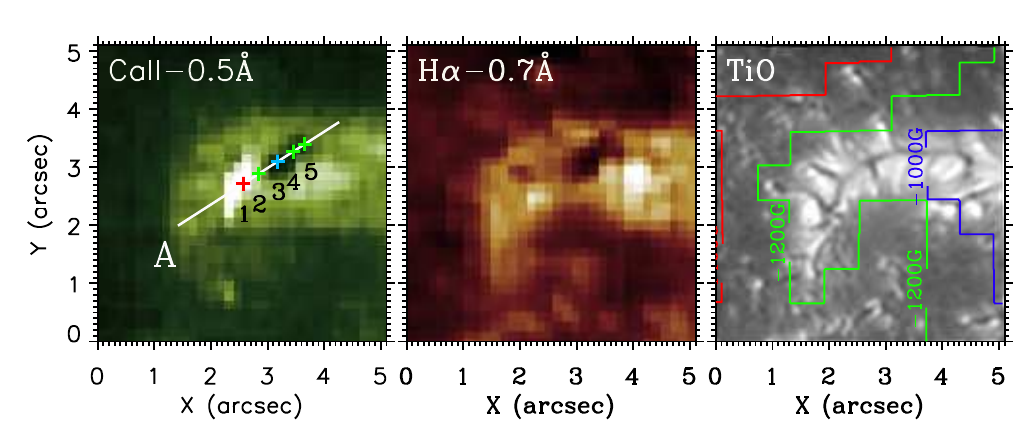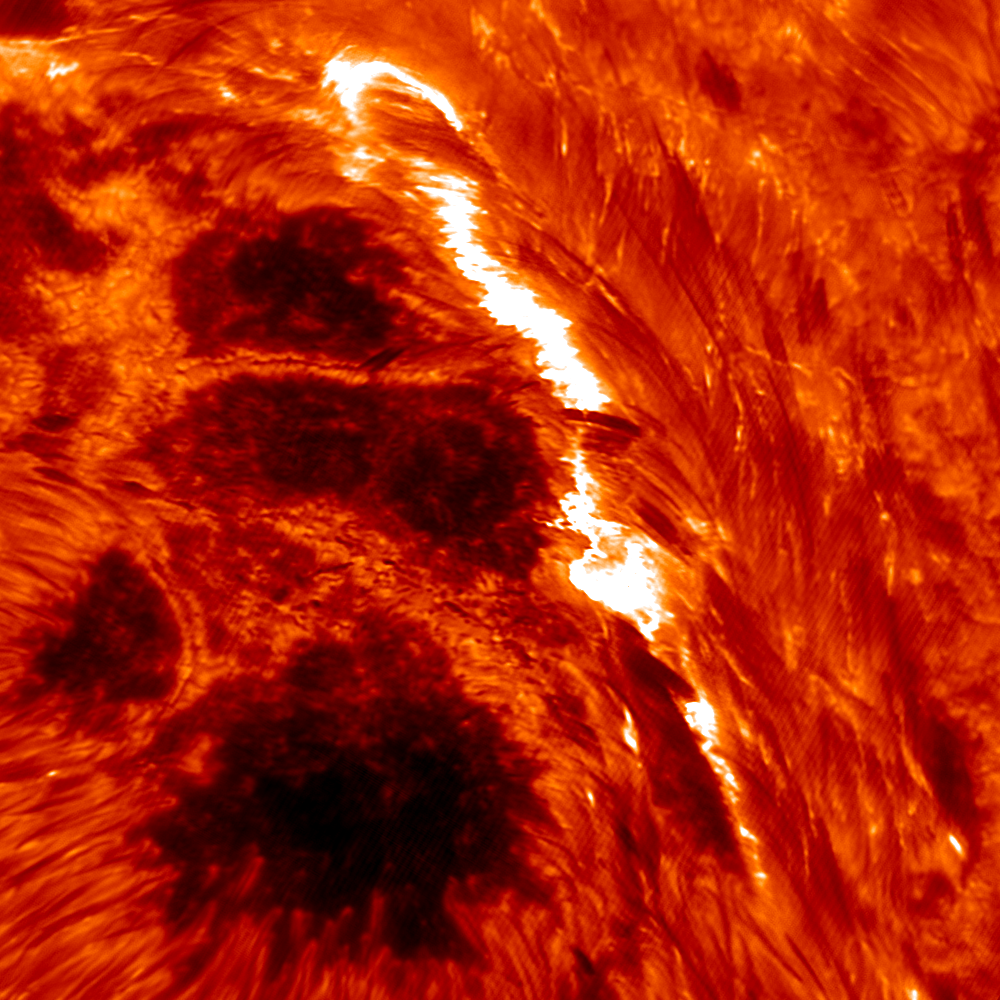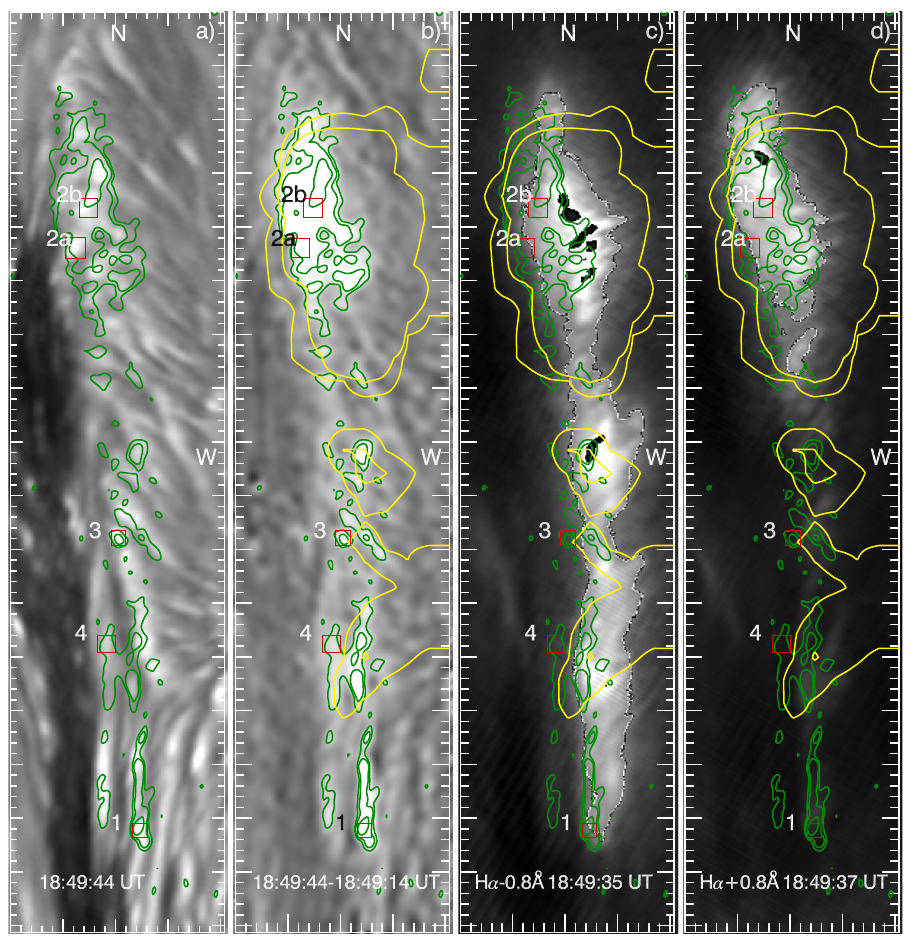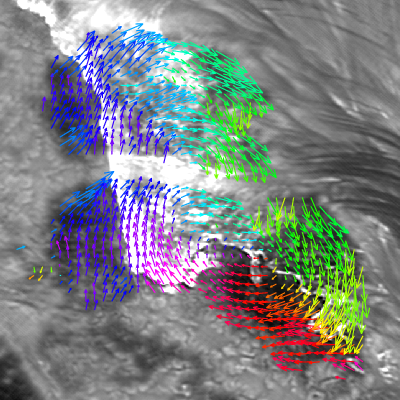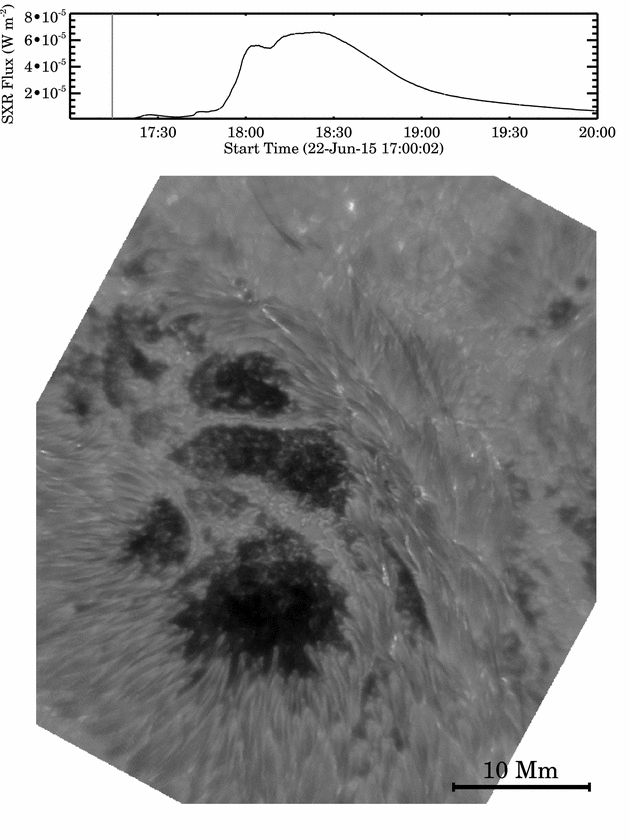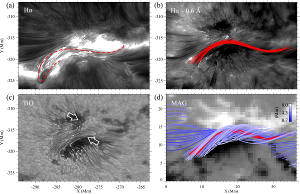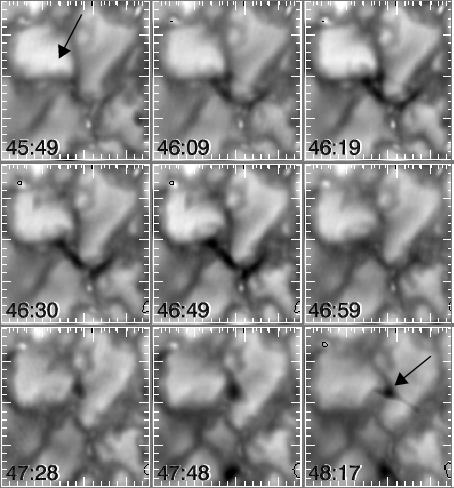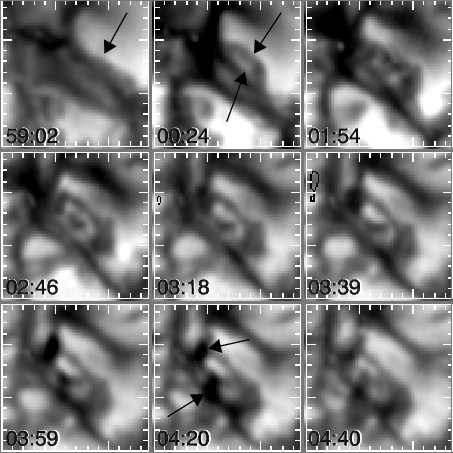|
|
|
| |
 Scientists
from the U.S. National Science Foundation National Solar Observatory and New Jersey Institute of Technology produced the
finest images of the Sun’s corona to date. To make these high-resolution images and movies, the team developed a new ‘coronal adaptive optics’
system that removes blur from images caused by the Earth’s atmosphere. Their ground-breaking results were recently published in Nature
Astronomy and pave the way for deeper insight into coronal heating, solar eruptions, and space weather, and open an opportunity for new discoveries
in the Sun’s atmosphere. Scientists
from the U.S. National Science Foundation National Solar Observatory and New Jersey Institute of Technology produced the
finest images of the Sun’s corona to date. To make these high-resolution images and movies, the team developed a new ‘coronal adaptive optics’
system that removes blur from images caused by the Earth’s atmosphere. Their ground-breaking results were recently published in Nature
Astronomy and pave the way for deeper insight into coronal heating, solar eruptions, and space weather, and open an opportunity for new discoveries
in the Sun’s atmosphere.
Original paper titled "Observations of fine coronal structures with high-order solar adaptive optics" by Dirk Schmidt (NSO), Thomas A. Schad (NSO), Vasyl Yurchyshyn (NJIT), Nicolas Gorceix (NJIT), Thomas R. Rimmele (NSO), and Philip R. Goode (NJIT) was published in May 2025 issue of Nature Astronomy. | |
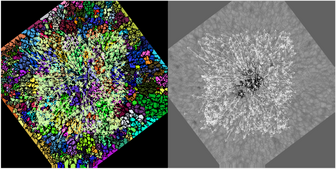 The interaction between magnetic fields and convection in sunspots during their decay process remains poorly understood, whereas the formation of sunspots is relatively well studied and fully modeled. The high spatial and temporal resolution of the GST instruments allowed us to analyze the causes of the decay of the sunspot. Afterward, they followed the emergence of granules in the moat region around the sunspot over six hours. The evolution of the trees of fragmenting granules (TFGs) was derived based on their relationship with the horizontal surface flows. Authors found that the area and total magnetic flux display an exponential decrease over the course of the sunspot decay. They identified 22 moving magnetic features (MMFs) in the moats of pores, which is a signature of sunspot decay through diffusion. The MMFs were constrained to follow the borders of TFGs during their journey away from the sunspot.
Authors concluded that the TFGs and their development contribute to the diffusion of the magnetic field outside the sunspot.
The interaction between magnetic fields and convection in sunspots during their decay process remains poorly understood, whereas the formation of sunspots is relatively well studied and fully modeled. The high spatial and temporal resolution of the GST instruments allowed us to analyze the causes of the decay of the sunspot. Afterward, they followed the emergence of granules in the moat region around the sunspot over six hours. The evolution of the trees of fragmenting granules (TFGs) was derived based on their relationship with the horizontal surface flows. Authors found that the area and total magnetic flux display an exponential decrease over the course of the sunspot decay. They identified 22 moving magnetic features (MMFs) in the moats of pores, which is a signature of sunspot decay through diffusion. The MMFs were constrained to follow the borders of TFGs during their journey away from the sunspot.
Authors concluded that the TFGs and their development contribute to the diffusion of the magnetic field outside the sunspot.
Original paper titled "Transport of the magnetic flux away from a decaying sunspot via convective motions
” by Zheng, C., Roudier, T., Schmieder, B., Ruan, G., Malherbe, J.-M., Liu, Y., Chen, Y., Cao, W. was published in June 2023 issue of Astron. Astrophys., 686, id.A75 | |
 High spatial-resolution NIRIS magnetograms where combined with HMI magnetograms and nonlinear force-free field (NLFFF) models to study magnetic structures associated with sunspot's light bridges (LBs). The effort revealed the existance of a field-free (or, more precisely, weak-field) region and the different velocity structures inside the two LBs. Analysis of the 3D NLFFF model showed a low-lying magnetic canopy as well as the enhanced current system above the LBs. The substantial difference between the LBs and umbrae is that the field lines emanating from the two LBs are more twisted than that from the neighboring umbrae.
High spatial-resolution NIRIS magnetograms where combined with HMI magnetograms and nonlinear force-free field (NLFFF) models to study magnetic structures associated with sunspot's light bridges (LBs). The effort revealed the existance of a field-free (or, more precisely, weak-field) region and the different velocity structures inside the two LBs. Analysis of the 3D NLFFF model showed a low-lying magnetic canopy as well as the enhanced current system above the LBs. The substantial difference between the LBs and umbrae is that the field lines emanating from the two LBs are more twisted than that from the neighboring umbrae.
Original paper titled "Solar Chromospheric Network as a Source for Solar Wind Switchbacks” by Jeongwoo Lee, Vasyl Yurchyshyn, Haimin Wang, Xu Yang, Wenda Cao, and Juan Carlos Martínez Oliveros was published in August 2022 issue of Astrophys. J. Lett., 935, L27 | |
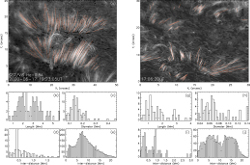 We have tested recent claims that the magnetic switchbacks (SBs) detected by the Parker Solar Probe (PSP) carry information on the scales of solar supergranulation and granulation using the high-resolution H-alpha images obtained with GST. As possible solar sources for SBs, we counted all the spicule-like features standing along the chromospheric networks near the coronal hole boundary visible in the H-alpha blue-wing but absent in the red-wing images and measure the geometric parameters of dense sections of individual flux tubes such as lengths, diameters, and inter-distances between them. We found that spicules standing along a chromospheric network near the coronal hole boundary present similar scales to the medium scale of SBs, but tending to be smaller than them. Considering the number of spicules within a network as high as 40-100, and the typical network diameter of 0.6℃-1.8℃, we argue that the medium scale of SBs can, in fact, be understood as an equilibrium distance between flux tubes in solar wind resulting from random walk within each diverging magnetic field funnel.
We have tested recent claims that the magnetic switchbacks (SBs) detected by the Parker Solar Probe (PSP) carry information on the scales of solar supergranulation and granulation using the high-resolution H-alpha images obtained with GST. As possible solar sources for SBs, we counted all the spicule-like features standing along the chromospheric networks near the coronal hole boundary visible in the H-alpha blue-wing but absent in the red-wing images and measure the geometric parameters of dense sections of individual flux tubes such as lengths, diameters, and inter-distances between them. We found that spicules standing along a chromospheric network near the coronal hole boundary present similar scales to the medium scale of SBs, but tending to be smaller than them. Considering the number of spicules within a network as high as 40-100, and the typical network diameter of 0.6℃-1.8℃, we argue that the medium scale of SBs can, in fact, be understood as an equilibrium distance between flux tubes in solar wind resulting from random walk within each diverging magnetic field funnel.
Original paper titled "Solar Chromospheric Network as a Source for Solar Wind Switchbacks” by Jeongwoo Lee, Vasyl Yurchyshyn, Haimin Wang, Xu Yang, Wenda Cao, and Juan Carlos Martínez Oliveros was published in August 2022 issue of Astrophys. J. Lett., 935, L27 | |
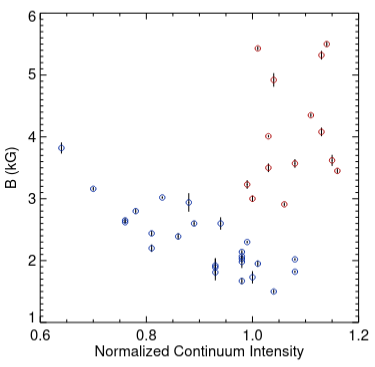 We studied very strong magnetic fields in active region (AR) NOAA 12673, which was the most flare productive AR in solar cycle 24. It produced four X-class flares including the X9.3 flare on 2017 September 06 and the X8.2 limb event on September 10. Our analysis is based on direct measurements of full Zeeman splitting of the Fe I 1564.85 nm line using all Stokes I, Q, U, and V profiles. This approach allowed us to obtain reliable estimates of the magnitude of magnetic fields independent of the filling factor and atmosphere models. Thus, the strongest fields up to 5.5 kG were found in a light bridge (LB) of a sunspot, while in the dark umbra magnetic fields did not exceed 4 kG. In case of the LB, the magnitude of the magnetic field is not related to the underlying continuum intensity, while in case of umbral fields we observed a well-known anti-correlation between the continuum intensity and the field magnitude. In this study, the LB was cospatial with a polarity inversion line of δ-sunspot, and we speculate that the 5.5 kG strong horizontal fields may be associated with a compact twisted flux rope at or near the photosphere. Comparison of the depth of the Zeeman π and σ components showed that in the LB magnetic fields are, on average, more horizontal than those in the dark umbra.
We studied very strong magnetic fields in active region (AR) NOAA 12673, which was the most flare productive AR in solar cycle 24. It produced four X-class flares including the X9.3 flare on 2017 September 06 and the X8.2 limb event on September 10. Our analysis is based on direct measurements of full Zeeman splitting of the Fe I 1564.85 nm line using all Stokes I, Q, U, and V profiles. This approach allowed us to obtain reliable estimates of the magnitude of magnetic fields independent of the filling factor and atmosphere models. Thus, the strongest fields up to 5.5 kG were found in a light bridge (LB) of a sunspot, while in the dark umbra magnetic fields did not exceed 4 kG. In case of the LB, the magnitude of the magnetic field is not related to the underlying continuum intensity, while in case of umbral fields we observed a well-known anti-correlation between the continuum intensity and the field magnitude. In this study, the LB was cospatial with a polarity inversion line of δ-sunspot, and we speculate that the 5.5 kG strong horizontal fields may be associated with a compact twisted flux rope at or near the photosphere. Comparison of the depth of the Zeeman π and σ components showed that in the LB magnetic fields are, on average, more horizontal than those in the dark umbra.
Original paper titled "Observations of Extremely Strong Magnetic Fields in Active Region NOAA 12673 Using GST Magnetic Field Measurement" by Lozitsky Vsevolod, Yurchyshyn Vasyl, Ahn Kwangsu, and Wang Haimin was published in March 2022 issue of Astrophys. J., 928, 41 | |
|
| |
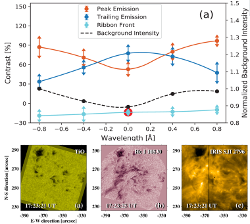 The main manifestation of flares is extensive emission over much of the electromagnetic spectrum. Intriguingly, under some special circumstances, negative flare contrasts (decrease of intensity) are occasionally reported in visible continuum and helium-line observations. In a previous study, negative flares in the He 10830Å were reported using monochromatic narrow-band observations with GST. It is representative of the line’s general behavior if the line profile remains symmetric or the intensity varies in the same direction for the entire line. However, one can imagine scenarios in which a part of the line is in emission while the rest remains in absorption (e.g. due to Doppler motions). In this study, we present a C3.0 flare observed on May 28, 2018 at 17:10 UT by GST and IRIS. NIRIS instrument scaned five spectral positions at ±0.8Å , ±0.4Å and the line center the spectral imaging mode. At the leading edge of the flare ribbon the line was observed to undergo enhanced absorption, while the rest of the ribbon was observed to be in emission. When in emission, the contrast, as compared to the pre-flare level, ranged from about 30% to nearly 100% dependong on the spectral position. Two types of spectra, "convex" shape with higher intensity at line core and "concave" shape with higher emission in the line wings, wre found at the trailing and peak flare areas, respectively. At the ribbon front, negative contrasts, or enhanced absorption, of about 10% - 20% appeared in all five wavelengths. These observations strongly suggest that the negative flare is a consequence of energy injection, namely non-thermal collisional ionization of helium caused by the precipitation of high energy electrons, as found in our recent numerical modeling results. In addition, though not strictly simultaneous, observations in the Mg II line using the IRIS spacecraft, show an obvious central reversal pattern at the locations where enhanced absorption of He I 10830Å is seen, which is in consistent with previous observations.
The main manifestation of flares is extensive emission over much of the electromagnetic spectrum. Intriguingly, under some special circumstances, negative flare contrasts (decrease of intensity) are occasionally reported in visible continuum and helium-line observations. In a previous study, negative flares in the He 10830Å were reported using monochromatic narrow-band observations with GST. It is representative of the line’s general behavior if the line profile remains symmetric or the intensity varies in the same direction for the entire line. However, one can imagine scenarios in which a part of the line is in emission while the rest remains in absorption (e.g. due to Doppler motions). In this study, we present a C3.0 flare observed on May 28, 2018 at 17:10 UT by GST and IRIS. NIRIS instrument scaned five spectral positions at ±0.8Å , ±0.4Å and the line center the spectral imaging mode. At the leading edge of the flare ribbon the line was observed to undergo enhanced absorption, while the rest of the ribbon was observed to be in emission. When in emission, the contrast, as compared to the pre-flare level, ranged from about 30% to nearly 100% dependong on the spectral position. Two types of spectra, "convex" shape with higher intensity at line core and "concave" shape with higher emission in the line wings, wre found at the trailing and peak flare areas, respectively. At the ribbon front, negative contrasts, or enhanced absorption, of about 10% - 20% appeared in all five wavelengths. These observations strongly suggest that the negative flare is a consequence of energy injection, namely non-thermal collisional ionization of helium caused by the precipitation of high energy electrons, as found in our recent numerical modeling results. In addition, though not strictly simultaneous, observations in the Mg II line using the IRIS spacecraft, show an obvious central reversal pattern at the locations where enhanced absorption of He I 10830Å is seen, which is in consistent with previous observations.
Original paper titled "Multi-passband Observations of a Solar Flare over the He I 10830Å line" by Yan Xu, Xu Yang, Graham S. Kerr, Vanessa Polito, Viacheslav M. Sadykov, Ju Jing, Wenda Cao, and Haimin Wang was published in January 2022 issue of Astrophys. J. Lett., 924/1, L18 (ADS) | |
|
| |
 The net sunlight reaching the Earth's climate system depends on the solar irradiance and the Earth's reflectance (albedo). We have observed earthshine from Big Bear Solar Observatory to measure the terrestrial albedo. For earthshine we measure the sunlight reflected from Earth to the dark part of the lunar face and back to the nighttime observer, yielding an instantaneous large-scale reflectance of the Earth. In these relative measurements, we also observe the sunlit, bright part of the lunar face. We report here reflectance data (monthly, seasonal and annual) covering two decades, 1998–2017. The albedo shows a decline corresponding to a net climate forcing of about 0.5 W/m2. We find no correlation between measures of solar cycle variations and the albedo variations. The first precise satellite measures of terrestrial albedo came with CERES. CERES global albedo data (2001-) show a decrease in forcing that is about twice that of earthshine measurements. The evolutionary changes in albedo motivate continuing earthshine observations as a complement to absolute satellite measurements, especially since earthshine and CERES measurements are sensitive to distinctly different parts of the angular reflectivity. The recent drop in albedo is attributed to a warming of the eastern pacific, which is measured to reduce low-lying cloud cover and, thereby, the albedo.
The net sunlight reaching the Earth's climate system depends on the solar irradiance and the Earth's reflectance (albedo). We have observed earthshine from Big Bear Solar Observatory to measure the terrestrial albedo. For earthshine we measure the sunlight reflected from Earth to the dark part of the lunar face and back to the nighttime observer, yielding an instantaneous large-scale reflectance of the Earth. In these relative measurements, we also observe the sunlit, bright part of the lunar face. We report here reflectance data (monthly, seasonal and annual) covering two decades, 1998–2017. The albedo shows a decline corresponding to a net climate forcing of about 0.5 W/m2. We find no correlation between measures of solar cycle variations and the albedo variations. The first precise satellite measures of terrestrial albedo came with CERES. CERES global albedo data (2001-) show a decrease in forcing that is about twice that of earthshine measurements. The evolutionary changes in albedo motivate continuing earthshine observations as a complement to absolute satellite measurements, especially since earthshine and CERES measurements are sensitive to distinctly different parts of the angular reflectivity. The recent drop in albedo is attributed to a warming of the eastern pacific, which is measured to reduce low-lying cloud cover and, thereby, the albedo.
See Press Release in ScienceNews
Original paper titled "Earth's Albedo 1998-2017 as Measured From Earthshine"
Phil R. Goode, Enric Pallé, Alla Shoumko, Sergey Shoumko, Pilar Montañes-Rodriguez, Steve E. Koonin was published in August 2021 issue of Geophys. Res. Lett., 48/71, e2021GL094888 (ADS) | |
|
| |
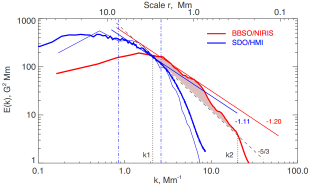 Line-of-sight magnetic fields and magnetic power spectra of a quite Sun region were analyzed using HMI and BBSO NIRIS data. The NIRIS data revealed the presence of thin flux tubes of 200-400~km in diameter and of field strength of 1000-2000~G. The HMI power spectra determined for a coronal hole, a quiet Sun region and a plage area exhibited the same spectral index of -1 on a broad range of spatial scales from 10-20~Mm down to 2.4~Mm. This implies that the same mechanism(s) of magnetic field generation operate everywhere in the undisturbed photosphere. When compared to the HMI spectra, the -1.2 slope of the NIRIS spectrum appeared to be extended into the short spatial range until the cutoff at 0.8-0.9~Mm, after which it continues with a steeper slope of -2.2. Comparison of the observed and Kolmogorov-type spectra allowed us to infer that the Kolmogorov turbulent cascade cannot account for more than 35% of the total magnetic energy observed in the scale range of 3.5-0.3~Mm. The energy excess can be attributed to other mechanisms of field generation such as the local turbulent dynamo and magnetic super-diffusivity observed in an undisturbed photosphere that can slow down the rate of the Kolmogorov cascade leading to a shallower resulting spectrum.
Line-of-sight magnetic fields and magnetic power spectra of a quite Sun region were analyzed using HMI and BBSO NIRIS data. The NIRIS data revealed the presence of thin flux tubes of 200-400~km in diameter and of field strength of 1000-2000~G. The HMI power spectra determined for a coronal hole, a quiet Sun region and a plage area exhibited the same spectral index of -1 on a broad range of spatial scales from 10-20~Mm down to 2.4~Mm. This implies that the same mechanism(s) of magnetic field generation operate everywhere in the undisturbed photosphere. When compared to the HMI spectra, the -1.2 slope of the NIRIS spectrum appeared to be extended into the short spatial range until the cutoff at 0.8-0.9~Mm, after which it continues with a steeper slope of -2.2. Comparison of the observed and Kolmogorov-type spectra allowed us to infer that the Kolmogorov turbulent cascade cannot account for more than 35% of the total magnetic energy observed in the scale range of 3.5-0.3~Mm. The energy excess can be attributed to other mechanisms of field generation such as the local turbulent dynamo and magnetic super-diffusivity observed in an undisturbed photosphere that can slow down the rate of the Kolmogorov cascade leading to a shallower resulting spectrum.
Original paper titled "Analysis of quiet-sun turbulence on the basis of SDO/HMI and Goode Solar Telescope data" by Valentina Abramenko and Vasyl Yurchyshyn was published in October 2020 issue of Monthly Notices of the Royal Astronomical Society, 497, Issue 4, 5405–5412 (ADS) | |
|
| |
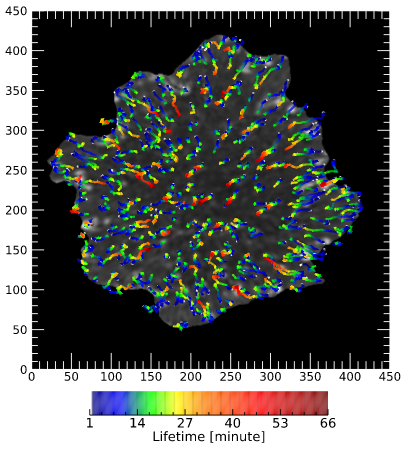 Authors refined physical parameters of umbral dots (UDs) using GST data and a particle tracking algorithm. They analyzed average position, spatial distribution and other properties of 2892 UDs. They report that the brightest, largest, fastest, and most elliptic UDs tend to be located at the umbra-penumbra boundary, while their lifetime does not display any meaningful location dependency. They have an elliptical shape with the averaged eccentricity of 0.29 and larger UDs tend to be more elliptic and more dynamic. The average dynamic velocity of all detected UDs is about twice (0.76 km/s) of the previously reported values, while tracking of the longest-lived 354 UDs showed that they generally move toward the center of the umbra (see figure). Some long-lived UDs generally exhibit similar periodic intensity fluctuations with period of 8.5-32, 3.5-4.1, 1.5-1.9, and 1.1-1.3 minutes.
Authors refined physical parameters of umbral dots (UDs) using GST data and a particle tracking algorithm. They analyzed average position, spatial distribution and other properties of 2892 UDs. They report that the brightest, largest, fastest, and most elliptic UDs tend to be located at the umbra-penumbra boundary, while their lifetime does not display any meaningful location dependency. They have an elliptical shape with the averaged eccentricity of 0.29 and larger UDs tend to be more elliptic and more dynamic. The average dynamic velocity of all detected UDs is about twice (0.76 km/s) of the previously reported values, while tracking of the longest-lived 354 UDs showed that they generally move toward the center of the umbra (see figure). Some long-lived UDs generally exhibit similar periodic intensity fluctuations with period of 8.5-32, 3.5-4.1, 1.5-1.9, and 1.1-1.3 minutes.
Original paper titled "Physical Characteristics of Umbral Dots Derived from a High-Resolution Observations" by Ali Kilcik, Volkan Sarp, Vasyl Yurchyshyn, Jean-Pierre Rozelot, and Atila Ozguc, was published in April 2020 issue of Solar Physics, 295/4, article id.58 (ADS) | |
|
| |
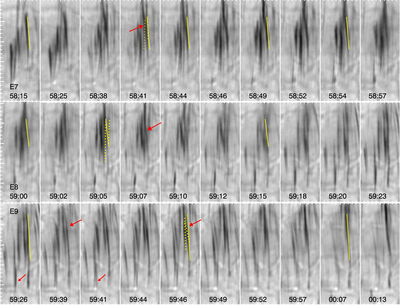 Authors inspected a 30 min long data set and found that very frequentlyH-alpha counterparts of type II spicules (RBEs) suddenly appear in situ}as non-extending plasma structures without prior H-alpha features and clear evidence of H-alpha emitting material being injected from below. They rapidly evolve on time scales of the order of 1s and their evolution includes inverted "Y", "V", "N", or parallel splitting (doubling) as well as sudden formation of a diffuse region followed by branching. The same feature may undergo several splitting episodes within about 1 min time interval. Two events considered in the present study do exhibit morphological features and evolutionary pattern consistent with the flux cancellation scenario. New flux emergence may trigger enhanced spicule activity observed as bursts of RBEs. These may suggest that in addition to directly driving the RBEs, flux emergence may also cause both re-structuring of coronal fields and wave generation, which in turn may be responsible for the rapid RBE transformations reported here. Furthermore, waves are also generated by vigorous turbulent flows. The MHD waves experience reflection near the TR and propagate downward. All these may create complex and dynamic interactions when coronal fields withing a flux tube attempt to counter the de-stabilizing driving force and injection of energy via multiple small-scale reconnection events occurring throughout the volume.
The events presented in the study resemble the well-known idea of inter-twined and tangled magnetic field lines. The criss-crossing patterns formed by RBEs are also somewhat similar to the synthetic emission of UV strands heated via multiple reconnections of tangled field lines within a flux tube. However, while it is tempting to interpret the RBE transformations as driven by component magnetic reconnection, we should be mindful that the appearance of energy release regions associated with reconnection in a braided magnetic structure may be wavelength and geometry dependent.
Authors inspected a 30 min long data set and found that very frequentlyH-alpha counterparts of type II spicules (RBEs) suddenly appear in situ}as non-extending plasma structures without prior H-alpha features and clear evidence of H-alpha emitting material being injected from below. They rapidly evolve on time scales of the order of 1s and their evolution includes inverted "Y", "V", "N", or parallel splitting (doubling) as well as sudden formation of a diffuse region followed by branching. The same feature may undergo several splitting episodes within about 1 min time interval. Two events considered in the present study do exhibit morphological features and evolutionary pattern consistent with the flux cancellation scenario. New flux emergence may trigger enhanced spicule activity observed as bursts of RBEs. These may suggest that in addition to directly driving the RBEs, flux emergence may also cause both re-structuring of coronal fields and wave generation, which in turn may be responsible for the rapid RBE transformations reported here. Furthermore, waves are also generated by vigorous turbulent flows. The MHD waves experience reflection near the TR and propagate downward. All these may create complex and dynamic interactions when coronal fields withing a flux tube attempt to counter the de-stabilizing driving force and injection of energy via multiple small-scale reconnection events occurring throughout the volume.
The events presented in the study resemble the well-known idea of inter-twined and tangled magnetic field lines. The criss-crossing patterns formed by RBEs are also somewhat similar to the synthetic emission of UV strands heated via multiple reconnections of tangled field lines within a flux tube. However, while it is tempting to interpret the RBE transformations as driven by component magnetic reconnection, we should be mindful that the appearance of energy release regions associated with reconnection in a braided magnetic structure may be wavelength and geometry dependent.
Original paper titled "Rapid Evolution of Type II Spicules Observed in Goode Solar Telescope On-disk Hα Images" by Vasyl Yurchyshyn, Wenda Cao, Valentina Abramenko, Xu Yang, and Kyung-Suk Cho, was published in March 2020 issue of Astrophysical Journal Letters, 891/1 (ADS) | |
|
| |
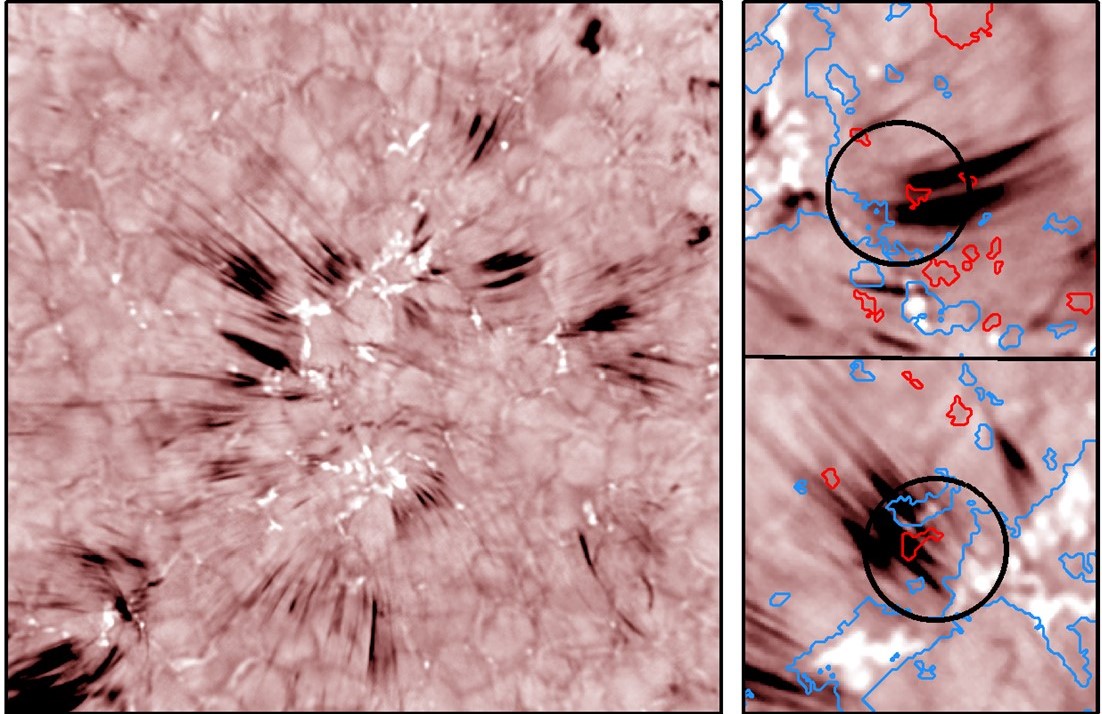 A new study on the highly-debated and fundamental astrophysical topic of solar spicules was published in Science.
The study is based on observations
with the 1.6-m Goode Solar Telescope (GST) at the Big Bear Solar Observatory (BBSO), the world’s largest solar telescope that is
currently operational. The telescope observed copious spicules at ultra-high spatial resolution (~45 km) and high cadence (~3.5 s) using
the Hydrogen-alpha (Hα) spectral line, and simultaneously measured the magnetic fields in the solar photosphere at high-spatial
resolution of about ~150 km (see the data overview movie)
A new study on the highly-debated and fundamental astrophysical topic of solar spicules was published in Science.
The study is based on observations
with the 1.6-m Goode Solar Telescope (GST) at the Big Bear Solar Observatory (BBSO), the world’s largest solar telescope that is
currently operational. The telescope observed copious spicules at ultra-high spatial resolution (~45 km) and high cadence (~3.5 s) using
the Hydrogen-alpha (Hα) spectral line, and simultaneously measured the magnetic fields in the solar photosphere at high-spatial
resolution of about ~150 km (see the data overview movie)Their observations show that the dynamic interaction of magnetic fields with different polarities is responsible for the generation of many spicules. Spicules mostly originate from the boundaries of the so-called magnetic network (a grid-like pattern on the solar surface where the magnetic field is highly concentrated into vertical tubes). Bursts of spicules are often accompanied by the emergence of new magnetic elements near the spicule footpoints, where the newly emerging magnetic elements have a polarity opposite to the dominant polarity of the already existing magnetic network (see figure). Although small-scale magnetic flux emerges ubiquitously in the quiet Sun, only when it is close to the strong existing network fields (often within 3000 km) does it generate spicules (see the results summary movie). Magnetic flux cancellation (the decrease of magnetic flux with time when two opposite-polarity flux elements run into each other), a signature of magnetic field line reconnection, is clearly identified at the footpoints of some spicules.
Original paper titled "Generation of Solar Spicules and Subsequent Atmospheric Heating" by T. Samanta, H. Tian, V. Yurchyshyn, H. Peter, W. Cao, A. Sterling, R. Erdélyi, K. Ahn, S. Feng, D. Utz, D. Banerjee, Y. Chen, was published in November issue of Science, 366, 890 (ADS) | |
|
| |
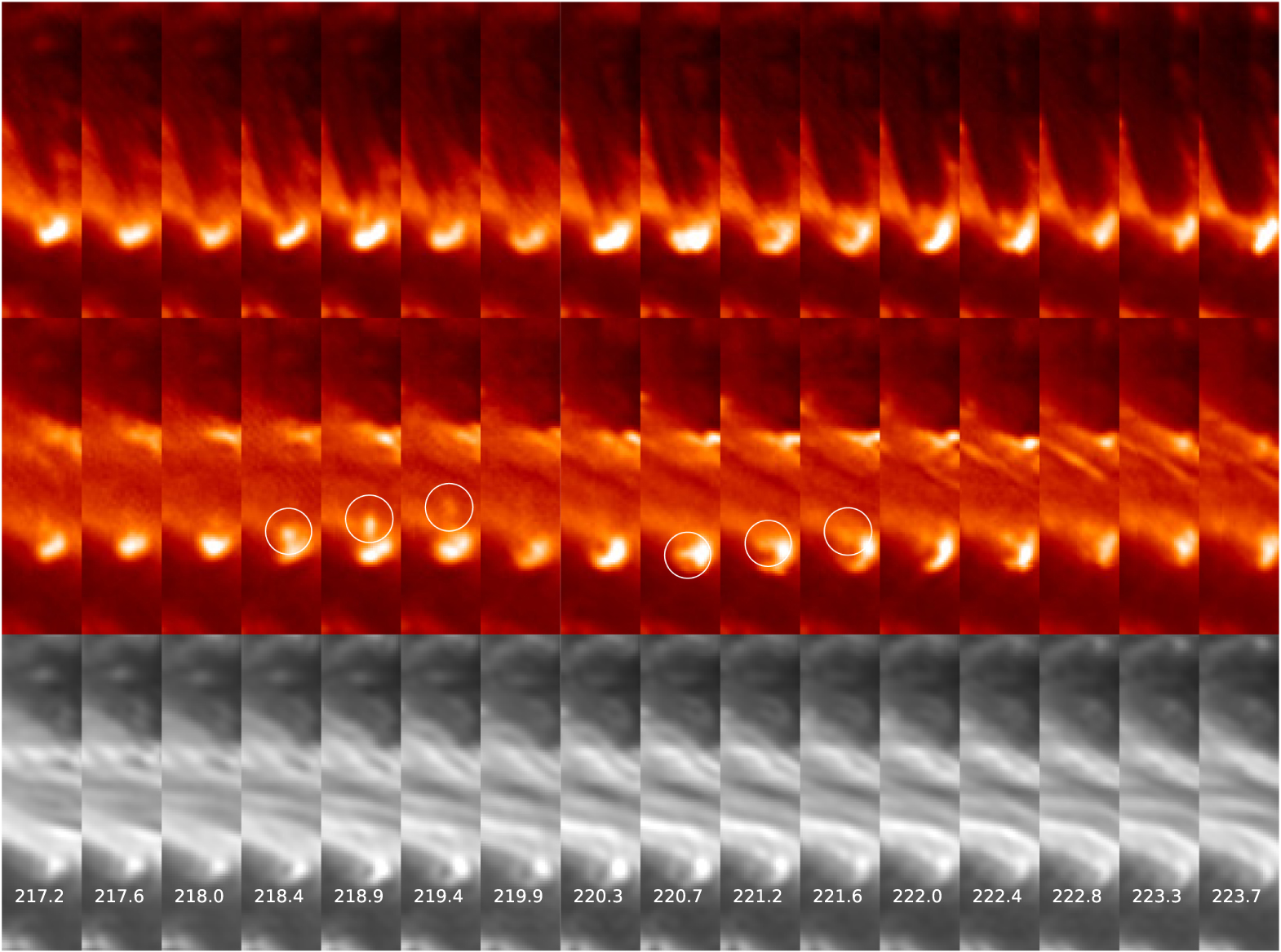 H-alpha surges are jets of cool chromospheric plasmas protruding into the solar corona 10-100 Mm above the photosphere. They have long been studied for decades, however, their driving mechanisms is still elusive. This study reports on the successive occurrence of 0".5 wide photospheric vortices (movie) with strong transverse shear flows at the edge of a sunspot light bridge (LB), and the subsequent ejection of chromospheric surges observed using a VIS, TiO filter, NIRIS. The H-alpha surges ejected at the location of the vortices often appeared in a hollow cylindrical structure. We also observed quasi-periodic vortex-associated bright Hα plasma blobs moving upward with a speed of up to 4 km/s. In view of the strong shear flow at the edge of the LB, it is likely that the vortices form under the Kelvin–Helmholtz instability. The surges may result from either the magnetic tension generated after magnetic reconnection or an acoustic impulse of a fast photospheric transverse flow. Otherwise, the surges could also be associated with Alfvénic waves, in which case their origin could be torsional magnetic fields generated in the process of the vortex formation.
H-alpha surges are jets of cool chromospheric plasmas protruding into the solar corona 10-100 Mm above the photosphere. They have long been studied for decades, however, their driving mechanisms is still elusive. This study reports on the successive occurrence of 0".5 wide photospheric vortices (movie) with strong transverse shear flows at the edge of a sunspot light bridge (LB), and the subsequent ejection of chromospheric surges observed using a VIS, TiO filter, NIRIS. The H-alpha surges ejected at the location of the vortices often appeared in a hollow cylindrical structure. We also observed quasi-periodic vortex-associated bright Hα plasma blobs moving upward with a speed of up to 4 km/s. In view of the strong shear flow at the edge of the LB, it is likely that the vortices form under the Kelvin–Helmholtz instability. The surges may result from either the magnetic tension generated after magnetic reconnection or an acoustic impulse of a fast photospheric transverse flow. Otherwise, the surges could also be associated with Alfvénic waves, in which case their origin could be torsional magnetic fields generated in the process of the vortex formation.
Original paper titled "Vortex Formations and Its Associated Surges in a Sunspot Light Bridge" by Heesu Yang, Eun-Kyung Lim, Haruhisa Iijima, Vasyl Yurchyshyn, Kyung-Suk Cho, Jeongwoo Lee, Brigitte Schmieder, Yeon-Han Kim, Sujin Kim, and Su-Chan Bong was published in the Sept 16 2019 issue of the Astrophysical Journal (ADS) | |
|
| |
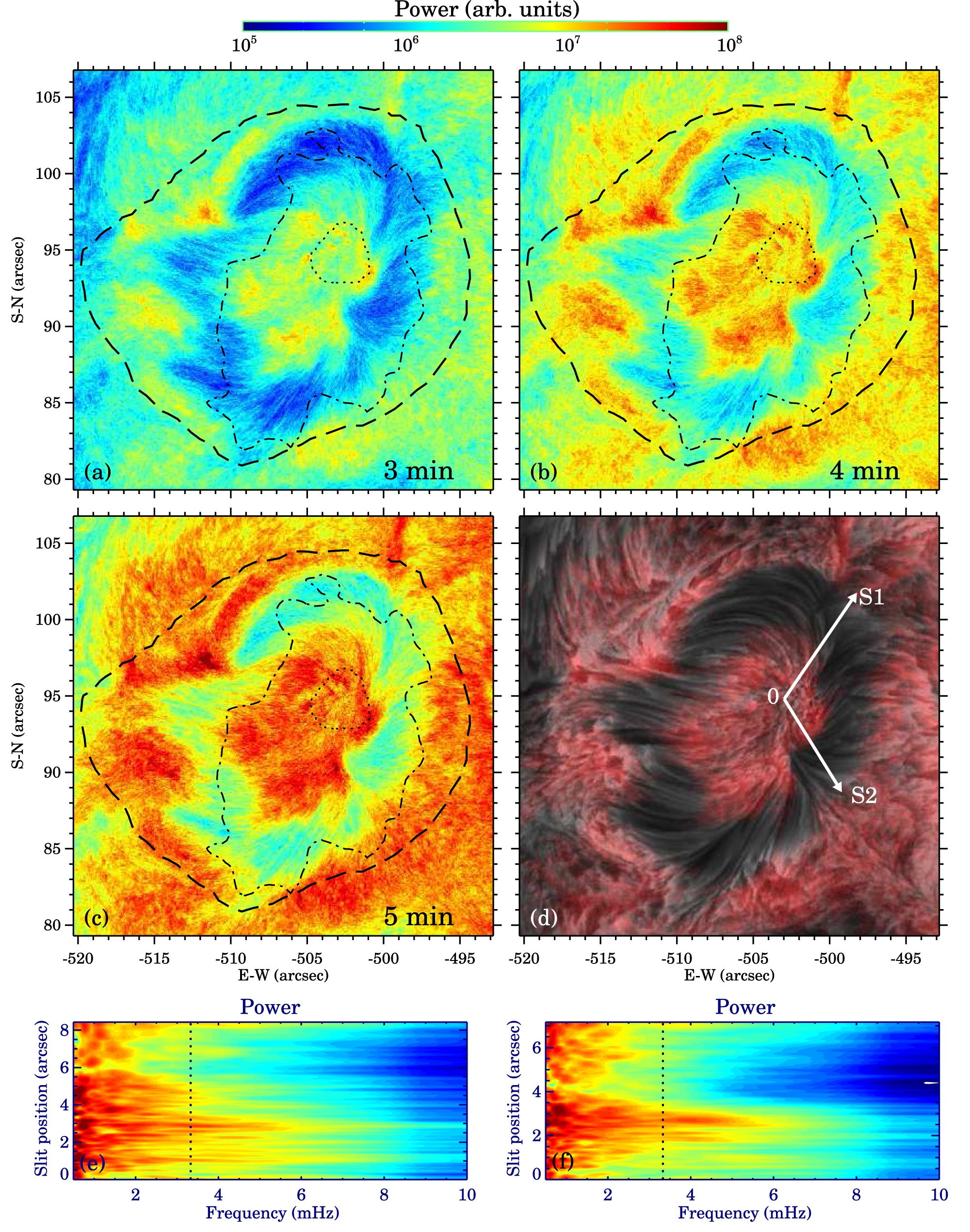 GST observations revealed copious fine-scale chromospheric superpenumbral fibrils (with an average cross-sectional width of about 0".17, along with associated transit and intermittent flows with apparent speeds of 5-14 km/s. Applied wavelet analysis and the spatio-temporal pattern of superpenumbral fibrils suggested that the observed flows along fibrils are not likely an oscillation/wave phenomenon. Instead, they may be a phenomenon similar to inverse Evershed flows in the chromosphere. The three-dimensional potential field model indicated that the pore and the surrounding fibrils are enclosed by fan-field lines forming a separatrix dome configuration. Such a magnetically confined configuration may help to maintain the steadfastness of the superpenumbral fibril dynamics.
GST observations revealed copious fine-scale chromospheric superpenumbral fibrils (with an average cross-sectional width of about 0".17, along with associated transit and intermittent flows with apparent speeds of 5-14 km/s. Applied wavelet analysis and the spatio-temporal pattern of superpenumbral fibrils suggested that the observed flows along fibrils are not likely an oscillation/wave phenomenon. Instead, they may be a phenomenon similar to inverse Evershed flows in the chromosphere. The three-dimensional potential field model indicated that the pore and the surrounding fibrils are enclosed by fan-field lines forming a separatrix dome configuration. Such a magnetically confined configuration may help to maintain the steadfastness of the superpenumbral fibril dynamics.
Original paper titled "High-resolution Observations of Dynamics of Superpenumbral H-alpha Fibrils" by Ju Jing, Qin Li, Chang Liu, Jeongwoo Lee, Yan Xu, Wenda Cao, and Haimin Wang was published in the Aug 5 2019 issue of the Astrophysical Journal (ADS) | |
|
| |
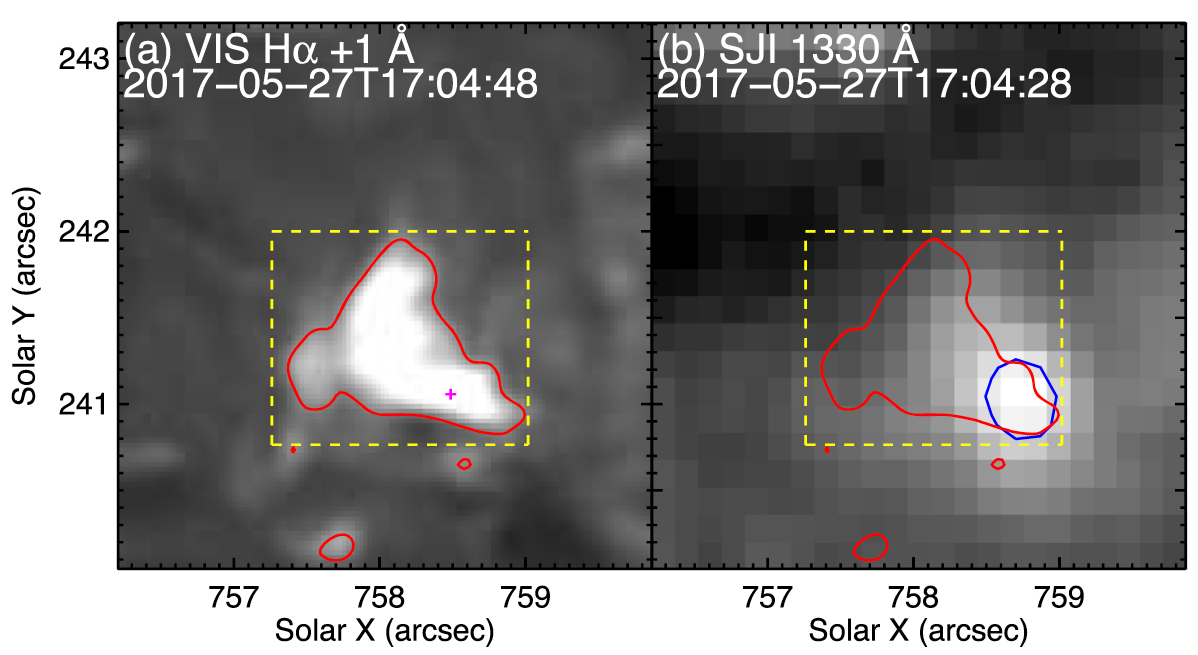 Ellerman bombs (EBs) are small-scale intense brightenings in Hα wing images, which are generally believed to be signatures of magnetic reconnection around the temperature minimum region of the solar atmosphere. They have a flame-like morphology when observed near the solar limb. Recent observations from the Interface Region Imaging Spectrograph (IRIS) reveal another type of small-scale reconnection event called ultraviolet (UV) bursts, in the lower solar atmosphere. Though previous observations have shown a clear coincidence between the occurrence of some UV bursts and EBs, the exact relationship between these two phenomena is still debated. We investigate the spatial and temporal relationship between flame-like EBs and UV bursts using joint near-limb observations between the 1.6 m Goode Solar Telescope (GST) and IRIS. In total, 161 EBs have been identified from the GST observations, and ∼ 20 of them reveal signatures of UV bursts in the IRIS images. Interestingly, we find that these UV bursts have a tendency to appear at the upper parts of their associated flame-like EBs. The intensity variations of most EB-related UV bursts and their corresponding EBs match well. These results suggest that some of these UV bursts and EBs likely form at different heights during a common reconnection process. During flux emergence a nearly vertical current sheet may form and extend from the photosphere to the chromosphere. The current sheet could be located between the two sides of a U-loop produced through interaction between the emerging flux and convection, or at the interface between the emerging flux and an overlying field. As the current sheet becomes thinner, plasmoid instability is switched on. As a result, fast reconnection occurs and plasmoids are generated at different heights of the current sheet. Reconnections at chromospheric heights produce UV bursts, whereas lower-height reconnections within the same current sheet produce EBs.
Ellerman bombs (EBs) are small-scale intense brightenings in Hα wing images, which are generally believed to be signatures of magnetic reconnection around the temperature minimum region of the solar atmosphere. They have a flame-like morphology when observed near the solar limb. Recent observations from the Interface Region Imaging Spectrograph (IRIS) reveal another type of small-scale reconnection event called ultraviolet (UV) bursts, in the lower solar atmosphere. Though previous observations have shown a clear coincidence between the occurrence of some UV bursts and EBs, the exact relationship between these two phenomena is still debated. We investigate the spatial and temporal relationship between flame-like EBs and UV bursts using joint near-limb observations between the 1.6 m Goode Solar Telescope (GST) and IRIS. In total, 161 EBs have been identified from the GST observations, and ∼ 20 of them reveal signatures of UV bursts in the IRIS images. Interestingly, we find that these UV bursts have a tendency to appear at the upper parts of their associated flame-like EBs. The intensity variations of most EB-related UV bursts and their corresponding EBs match well. These results suggest that some of these UV bursts and EBs likely form at different heights during a common reconnection process. During flux emergence a nearly vertical current sheet may form and extend from the photosphere to the chromosphere. The current sheet could be located between the two sides of a U-loop produced through interaction between the emerging flux and convection, or at the interface between the emerging flux and an overlying field. As the current sheet becomes thinner, plasmoid instability is switched on. As a result, fast reconnection occurs and plasmoids are generated at different heights of the current sheet. Reconnections at chromospheric heights produce UV bursts, whereas lower-height reconnections within the same current sheet produce EBs.
Original paper titled "Flame-like Ellerman Bombs and Their Connection to Solar Ultraviolet Bursts" by Yajie Chen, Hui Tian, Hardi Peter, Tanmoy Samanta, Vasyl Yurchyshyn, Haimin Wang, Wenda Cao, Linghua Wang and Jiansen He was published in the April 20 2019 issue of the Astrophysical Journal Letters (IOP ApJ Lett) | |
|
| |
 Detailed observations of magnetic environment at four footpoints of two warm coronal loops showed that loop brightening episodes were associated with magnetic flux emergence and cancellation processes observed in SDO’s Helioseismic and Magnetic Imager and GST’s Near InfraRed Imaging Spectrapolarimeter data. The observed activity was driven by magnetic reconnection between small-scale emerging dipoles and large-scale pre-existing fields, suggesting that the reconnection occurred in the lower chromosphere at the edge of an extended plage region, where the loops were rooted. Data suggested that plasma, evaporated during these reconnection events, gradually filled the loops and as it cooled the visible density front propagated from one footpoint of the loop to another at a rate of 90-110 km/s. This study also indicates that at least some of the bright loops seen in SDO Atmospheric Imaging Assembly images rooted in sunspot umbra may be heated due to magnetic activity taking place at the remote (nonsunspot) footpoint.
Detailed observations of magnetic environment at four footpoints of two warm coronal loops showed that loop brightening episodes were associated with magnetic flux emergence and cancellation processes observed in SDO’s Helioseismic and Magnetic Imager and GST’s Near InfraRed Imaging Spectrapolarimeter data. The observed activity was driven by magnetic reconnection between small-scale emerging dipoles and large-scale pre-existing fields, suggesting that the reconnection occurred in the lower chromosphere at the edge of an extended plage region, where the loops were rooted. Data suggested that plasma, evaporated during these reconnection events, gradually filled the loops and as it cooled the visible density front propagated from one footpoint of the loop to another at a rate of 90-110 km/s. This study also indicates that at least some of the bright loops seen in SDO Atmospheric Imaging Assembly images rooted in sunspot umbra may be heated due to magnetic activity taking place at the remote (nonsunspot) footpoint.
Original paper titled "Magnetic Field Dynamics and Varying Plasma Emission in Large-scale Coronal Loops" by Seray Şahin, Vasyl Yurchyshyn, Pankaj Kumar, Ali Kilcik, Kwangsu Ahn, and Xu Yang was published in the March 1 2019 issue of Astrophysical Journal (ADS) | |
|
| |
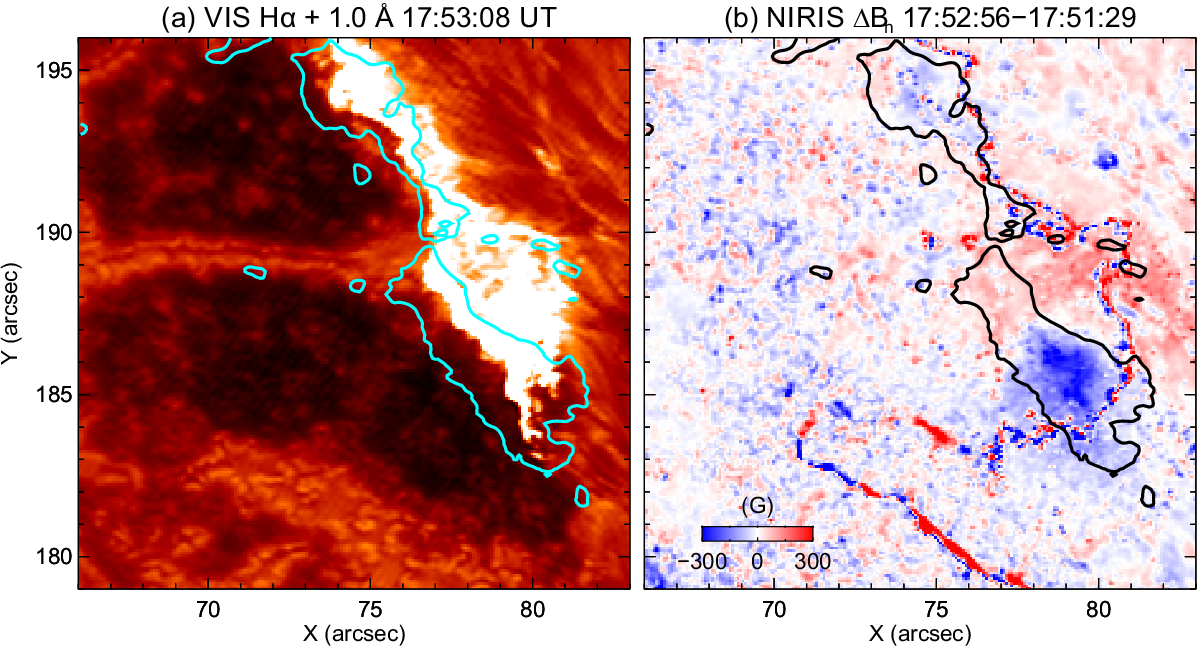 The photospheric response to solar flares, also known as coronal back reaction, is often observed as sudden flare-induced changes in the vector magnetic field and sunspot motions. However, it remains obscure whether evolving flare ribbons, A flare signature closest to the photosphere, are accompanied by any changes in the vector magnetic field therein. Here we explore the relationship between the dynamics of flare ribbons in the chromosphere and variations of magnetic fields in the underlying photosphere, using high-resolution off-band H-alpha images and near-infrared vector magnetograms of the M6.5 flare observed on 2015 June 22 with the 1.6 m Goode Solar Telescope at Big Bear Solar Observatory. We find that changes in the photospheric fields occur at the arrival of the flare ribbon front, and thus propagate in a way analogous to the moving flare ribbons. In general, the horizontal field increases and the field lines become more inclined. When ribbons sweep through regions that undergo a rotational motion, the fields transiently become more vertical with decreased horizontal field and inclination angle, and then restore and/or become more horizontal than before the ribbon arrival. The ribbon propagation decelerates near the sunspot rotation center, where the vertical field becomes permanently enhanced. Similar magnetic field changes were discerned in magnetograms from the Helioseismic and Magnetic Imager (HMI) of this event, and an inward collapse of coronal magnetic fields is inferred from the time sequence of nonlinear force-free field models extrapolated from HMI magnetograms. We conclude that photospheric fields respond nearly instantaneously to magnetic reconnection in the corona.
The photospheric response to solar flares, also known as coronal back reaction, is often observed as sudden flare-induced changes in the vector magnetic field and sunspot motions. However, it remains obscure whether evolving flare ribbons, A flare signature closest to the photosphere, are accompanied by any changes in the vector magnetic field therein. Here we explore the relationship between the dynamics of flare ribbons in the chromosphere and variations of magnetic fields in the underlying photosphere, using high-resolution off-band H-alpha images and near-infrared vector magnetograms of the M6.5 flare observed on 2015 June 22 with the 1.6 m Goode Solar Telescope at Big Bear Solar Observatory. We find that changes in the photospheric fields occur at the arrival of the flare ribbon front, and thus propagate in a way analogous to the moving flare ribbons. In general, the horizontal field increases and the field lines become more inclined. When ribbons sweep through regions that undergo a rotational motion, the fields transiently become more vertical with decreased horizontal field and inclination angle, and then restore and/or become more horizontal than before the ribbon arrival. The ribbon propagation decelerates near the sunspot rotation center, where the vertical field becomes permanently enhanced. Similar magnetic field changes were discerned in magnetograms from the Helioseismic and Magnetic Imager (HMI) of this event, and an inward collapse of coronal magnetic fields is inferred from the time sequence of nonlinear force-free field models extrapolated from HMI magnetograms. We conclude that photospheric fields respond nearly instantaneously to magnetic reconnection in the corona.
Original paper titled "Evolution of Photospheric Vector Magnetic Field Associated with Moving Flare Ribbons as Seen by GST" by Chang Liu, Wenda Cao, Jongchul Chae, Kwangsu Ahn, Debi Prasad Choudhary, Jeongwoo Lee, Rui Liu, Na Deng, Jiasheng Wang, and Haimin Wang was published in the December 7 2018 issue of Astrophysical Journal (IOP ApJ) | |
|
| |
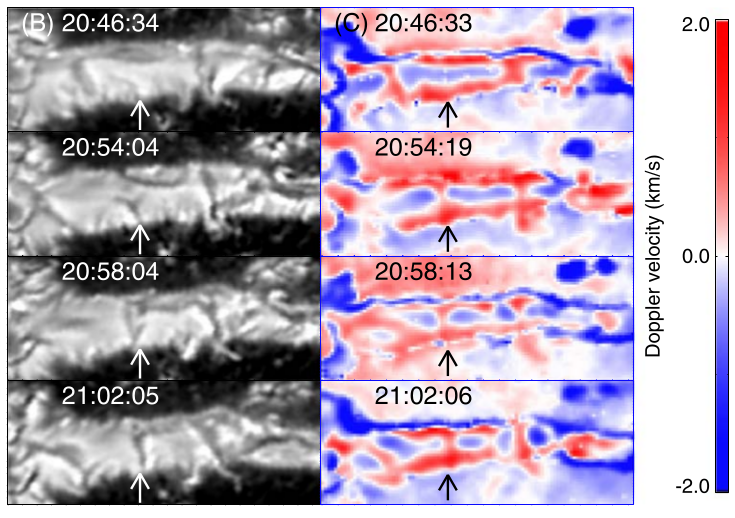 High-resolution observations have frequently revealed central dark lanes within bright substructures such as umbral dots, penumbral filaments and light bridges in sunspots. Observations of two light bridges with the 1.6 m Goode Solar Telescope at Big Bear Solar Observatory have revealed significant new insight into the physical processes in light bridges. Besides the central dark lane, GST detected a new feature in the first light bridge: dot-like dark knots. While in the second light bridge, originally the central dark lane is much fainter, and some transverse intergranular lanes have been observed. However, after one day of evolution, this wide light bridge becomes narrower, and the central dark lane and dark knots are clearly detected. Measurements of the Doppler shift and magnetic field by GST support the following scenario: a narrow light bridge is made up of a chain of convection cells, just like broader, granular light bridges. In the center of each convection cell, upflows raise up the tau=1 surface and result in a central dark lane. Whereas on the two endpoints of the convection cells, depending on the width of a light bridge, converging downflows may create dot-like dark knots or elongated intergranular lanes. By observing the dynamics of these dark structures, we now can infer some detailed information about the evolution of the convection cells.
High-resolution observations have frequently revealed central dark lanes within bright substructures such as umbral dots, penumbral filaments and light bridges in sunspots. Observations of two light bridges with the 1.6 m Goode Solar Telescope at Big Bear Solar Observatory have revealed significant new insight into the physical processes in light bridges. Besides the central dark lane, GST detected a new feature in the first light bridge: dot-like dark knots. While in the second light bridge, originally the central dark lane is much fainter, and some transverse intergranular lanes have been observed. However, after one day of evolution, this wide light bridge becomes narrower, and the central dark lane and dark knots are clearly detected. Measurements of the Doppler shift and magnetic field by GST support the following scenario: a narrow light bridge is made up of a chain of convection cells, just like broader, granular light bridges. In the center of each convection cell, upflows raise up the tau=1 surface and result in a central dark lane. Whereas on the two endpoints of the convection cells, depending on the width of a light bridge, converging downflows may create dot-like dark knots or elongated intergranular lanes. By observing the dynamics of these dark structures, we now can infer some detailed information about the evolution of the convection cells.
Original paper titled "Dark Structures in Sunspot Light Bridges" by Jingwen Zhang, Hui Tian, Sami K. Solanki, Haimin Wang, Hardi Peter, Kwangsu Ahn, Yan Xu, Yingjie Zhu, Wenda Cao, Jiansen He, and Linghua Wang was published in the September 20 2018 issue of Astrophysical Journal (IOP ApJ) | |
|
| |
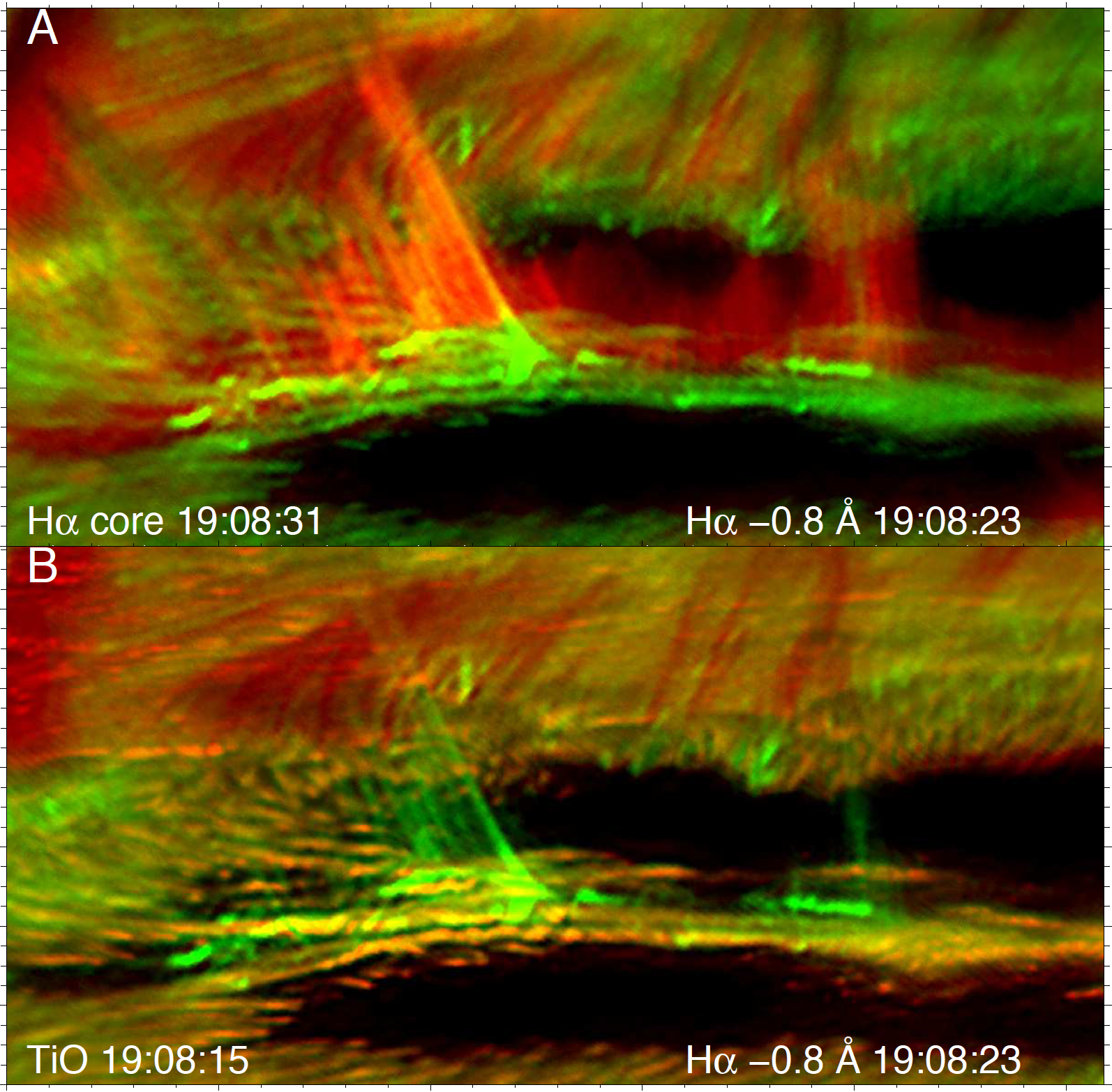 Magnetic reconnection, a physical process in which the magnetic field topology is rearranged and a part of the magnetic energy is converted into thermal and kinetic energy, is believed to be one of the most important energy release mechanisms in astrophysical, solar and space plasmas. In the light of the proposal that the solar atmosphere is powered by prevalent small-scale magnetic reconnection (Parker et al. 1988), efforts have been made to search for evidence of small-scale reconnection events in the solar atmosphere in the past 30 years. Recent high-resolution observations have revealed the frequent occurrence of jets with an inverted Y-shape in coronal holes and active regions outside sunspots. The inverted Y-shape appears to be a natural consequence of reconnection between small-scale magnetic bipoles (or a magnetic arcade) and the unipolar background fields, thus providing strong evidence for magnetic reconnection. Such inverted Y-shaped structures have been rarely observed within sunspots, the darkest regions with the strongest magnetic fields and lowest temperatures in the solar atmosphere. Using the 1.6-meter Goode Solar Telescope, we detect prevalent reconnection through frequently occurring fine-scale jets in the Hα line wings at light bridges, the bright lanes that may divide the dark sunspot core into multiple parts. Many jets have an inverted Y-shape, shown by models to be typical of reconnection in a unipolar field environment. Simultaneous spectral imaging data from the Interface Region Imaging Spectrograph show that the reconnection drives bidirectional flows up to 200 km/s, and that the weakly ionized plasma is heated by at least an order of magnitude up to 80,000 K. Such highly dynamic reconnection jets and efficient heating should be properly accounted for in future modeling efforts of sunspots. Our observations also reveal that the surge-like activity previously reported above light bridges in some chromospheric passbands such as the Hα core has two components: the ever-present short surges likely to be related to the upward leakage of magnetoacoustic waves from the photosphere, and the occasionally occurring long and fast surges that are obviously caused by the intermittent reconnection jets.
Magnetic reconnection, a physical process in which the magnetic field topology is rearranged and a part of the magnetic energy is converted into thermal and kinetic energy, is believed to be one of the most important energy release mechanisms in astrophysical, solar and space plasmas. In the light of the proposal that the solar atmosphere is powered by prevalent small-scale magnetic reconnection (Parker et al. 1988), efforts have been made to search for evidence of small-scale reconnection events in the solar atmosphere in the past 30 years. Recent high-resolution observations have revealed the frequent occurrence of jets with an inverted Y-shape in coronal holes and active regions outside sunspots. The inverted Y-shape appears to be a natural consequence of reconnection between small-scale magnetic bipoles (or a magnetic arcade) and the unipolar background fields, thus providing strong evidence for magnetic reconnection. Such inverted Y-shaped structures have been rarely observed within sunspots, the darkest regions with the strongest magnetic fields and lowest temperatures in the solar atmosphere. Using the 1.6-meter Goode Solar Telescope, we detect prevalent reconnection through frequently occurring fine-scale jets in the Hα line wings at light bridges, the bright lanes that may divide the dark sunspot core into multiple parts. Many jets have an inverted Y-shape, shown by models to be typical of reconnection in a unipolar field environment. Simultaneous spectral imaging data from the Interface Region Imaging Spectrograph show that the reconnection drives bidirectional flows up to 200 km/s, and that the weakly ionized plasma is heated by at least an order of magnitude up to 80,000 K. Such highly dynamic reconnection jets and efficient heating should be properly accounted for in future modeling efforts of sunspots. Our observations also reveal that the surge-like activity previously reported above light bridges in some chromospheric passbands such as the Hα core has two components: the ever-present short surges likely to be related to the upward leakage of magnetoacoustic waves from the photosphere, and the occasionally occurring long and fast surges that are obviously caused by the intermittent reconnection jets.
Original paper titled "Frequently Occurring Reconnection Jets from Sunspot Light Bridges" by Hui Tian, Vasyl Yurchyshyn, Hardi Peter, Sami K. Solanki, Peter R. Young, Lei Ni, Wenda Cao, Kaifan Ji, Yingjie Zhu, Jingwen Zhang, Tanmoy Samanta, Yongliang Song, Jiansen He, Linghua Wang, Yajie Chen was published in the February 20 2018 issue of Astrophysical Journal (ADS/ArXiv) | |
|
| |
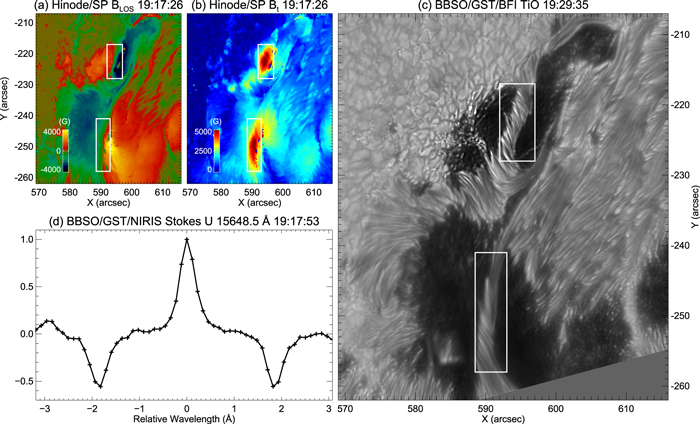 Solar Active Region (AR) 12673 is the most flare productive AR in the solar cycle 24. It produced four X-class flares including the X9.3 flare on 2017 September 06 and the X8.2 limb event on September 10.
In panels (a) and (b), we show the line-of-sight (LOS) and transverse magnetic field strength using the Hinode/SP level 2 data obtained a few hours after the X9.3 flare on 2017 September 06. While the LOS fields are under 5000 G, the transverse fields have several patches at the saturation level of 5000 G. It is obvious from panel (c) that light bridges (LBs) in these two sections of strongest transverse field areas exhibit a prominent alternating bright-dark spiral structure, which are different from the usual appearance of LBs such as those shown by Wang et al. (2018). Notably, the observed spiral filaments are not parallel to the PIL as is usually seen in the regular LBs, and implied by Yang et al. (2017) for strong shear along PIL. In Panel (d), we show a selected NIRIS Stokes U profile in the northern boxed region, where Hinode/SP level 2 data are saturated at 5000 G. Three Zeeman components are clearly seen. A direct measurement of the 1.9Å Zeeman splitting yields a field strength B of 5570 G, about 1300 G above what Zirin and Wang (1993) found for the strongest fields in flare productive sunspots.
Solar Active Region (AR) 12673 is the most flare productive AR in the solar cycle 24. It produced four X-class flares including the X9.3 flare on 2017 September 06 and the X8.2 limb event on September 10.
In panels (a) and (b), we show the line-of-sight (LOS) and transverse magnetic field strength using the Hinode/SP level 2 data obtained a few hours after the X9.3 flare on 2017 September 06. While the LOS fields are under 5000 G, the transverse fields have several patches at the saturation level of 5000 G. It is obvious from panel (c) that light bridges (LBs) in these two sections of strongest transverse field areas exhibit a prominent alternating bright-dark spiral structure, which are different from the usual appearance of LBs such as those shown by Wang et al. (2018). Notably, the observed spiral filaments are not parallel to the PIL as is usually seen in the regular LBs, and implied by Yang et al. (2017) for strong shear along PIL. In Panel (d), we show a selected NIRIS Stokes U profile in the northern boxed region, where Hinode/SP level 2 data are saturated at 5000 G. Three Zeeman components are clearly seen. A direct measurement of the 1.9Å Zeeman splitting yields a field strength B of 5570 G, about 1300 G above what Zirin and Wang (1993) found for the strongest fields in flare productive sunspots.
Original paper titled "Strong Transverse Photosphere Magnetic Fields and Twist in Light Bridge Dividing Delta Sunspot of Active Region 12673" by Haimin Wang, Vasyl Yurchyshyn, Chang Liu, Kwangsu Ahn, Shin Toriumi, and Wenda Cao was published in the January 12 2018 issue of Research Notes of the AAS |
|
| |
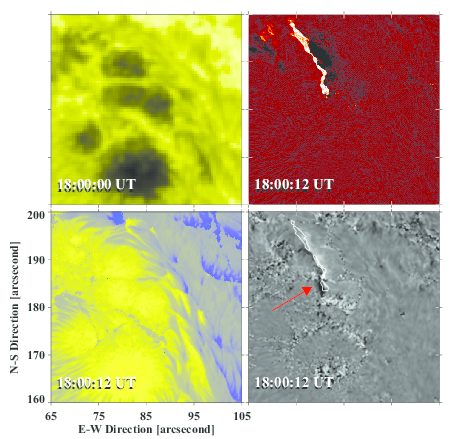 In addition to the radiation, significant changes of the magnetic field during flares have been reported in the literature, most of which are irreversible. In contrast to the stepwise temporal profile of permanent changes, the characteristic profile of a transient change is more like a δ-function in time. Transient changes were rarely reported. An example is a magnetic anomaly or a magnetic transient, a temporal reversal of magnetic polarities measured simultaneously with flare emission, first reported using BBSO data. The plausible explanation is that the Fe I 5324 Å line, used for magnetic field measurements, turns from absorption to emission due to the flare heating at lower layers of solar atmosphere. Recent space-based observations have further confirmed that the magnetic anomaly/transient is not a solar phenomenon, but an artifact of measurements. Taking advantage of the unprecedented resolution provided by the 1.6-m Goode Solar Telescope, here we show a sudden rotation of the magnetic field vector by about 12-20 degrees counterclockwise, in associatopn with a M6.5 flare observed on June 22, 2015. Such changes of the azimuth angles of the transverse magnetic field are well pronounced within a ribbon-like structure (~600 km in width), moving co-spatially and co-temporally with the flare emission as seen in the Hα line. A strong spatial correlation between the azimuth transient and the flare ribbon front indicates that the energetic electron beams are very likely to be the cause of the rotation. During the rotation, the measured azimuth becomes closer to that of a potential field indicating a process of energy release (untwist) in an associated flare loop. The magnetic fields restored their original direction after the flare ribbons swept through over the area. This is the first time that a transient field rotation is observed. Possible explanations of the phenomenon include 1) effect of induced magnetic fields; 2) effect of downward-drafting plasma; 3) polarization of emission lines due to return current and/or filamentary chromospheric evaporation; and 4) effects of Alfven waves. The observed field change cannot be explained by existing models. This new, transient magnetic signature in the photosphere that we observed here offers a new diagnostic tool for future modeling of magnetic reconnection and the resulting energy release. Such observations require high cadence and high resolution. Our results motivate further observations using GST and the Daniel K. Inouye Solar Telescope (DKIST) in probing the mystery of solar flares.
In addition to the radiation, significant changes of the magnetic field during flares have been reported in the literature, most of which are irreversible. In contrast to the stepwise temporal profile of permanent changes, the characteristic profile of a transient change is more like a δ-function in time. Transient changes were rarely reported. An example is a magnetic anomaly or a magnetic transient, a temporal reversal of magnetic polarities measured simultaneously with flare emission, first reported using BBSO data. The plausible explanation is that the Fe I 5324 Å line, used for magnetic field measurements, turns from absorption to emission due to the flare heating at lower layers of solar atmosphere. Recent space-based observations have further confirmed that the magnetic anomaly/transient is not a solar phenomenon, but an artifact of measurements. Taking advantage of the unprecedented resolution provided by the 1.6-m Goode Solar Telescope, here we show a sudden rotation of the magnetic field vector by about 12-20 degrees counterclockwise, in associatopn with a M6.5 flare observed on June 22, 2015. Such changes of the azimuth angles of the transverse magnetic field are well pronounced within a ribbon-like structure (~600 km in width), moving co-spatially and co-temporally with the flare emission as seen in the Hα line. A strong spatial correlation between the azimuth transient and the flare ribbon front indicates that the energetic electron beams are very likely to be the cause of the rotation. During the rotation, the measured azimuth becomes closer to that of a potential field indicating a process of energy release (untwist) in an associated flare loop. The magnetic fields restored their original direction after the flare ribbons swept through over the area. This is the first time that a transient field rotation is observed. Possible explanations of the phenomenon include 1) effect of induced magnetic fields; 2) effect of downward-drafting plasma; 3) polarization of emission lines due to return current and/or filamentary chromospheric evaporation; and 4) effects of Alfven waves. The observed field change cannot be explained by existing models. This new, transient magnetic signature in the photosphere that we observed here offers a new diagnostic tool for future modeling of magnetic reconnection and the resulting energy release. Such observations require high cadence and high resolution. Our results motivate further observations using GST and the Daniel K. Inouye Solar Telescope (DKIST) in probing the mystery of solar flares.
Original paper titled "Transient rotation of photospheric vector magnetic fields associated with a solar flare" by Yan Xu, Wenda Cao, Kwangsu Ahn, Ju Jing, Chang Liu, Jongchul Chae, Nengyi Huang, Na Deng, Dale E. Gary & Haimin Wang was published in the January 3 2018 issue of Nature Communications. |
|
|
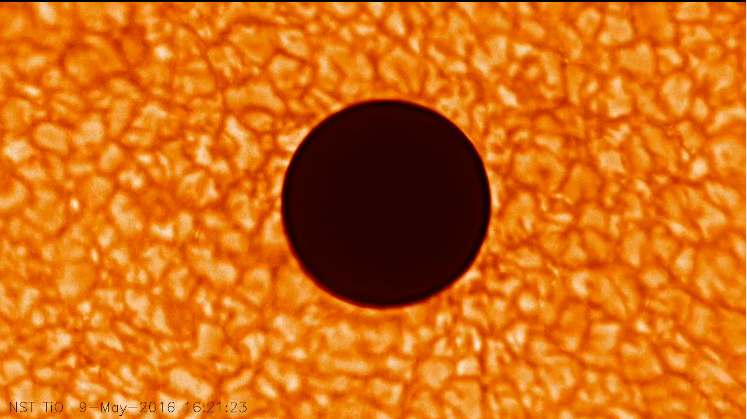
|
|
|
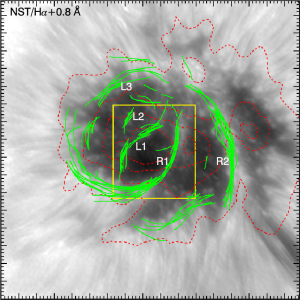 We analysed sunspot oscillations using Interface Region Imaging Spectrograph (IRIS) slit-jaw and spectral data and narrow-band chromospheric images from the New Solar Telescope (NST) for the main sunspot in NOAA AR 11836.
We traced and plotted with green line segments all the locations where UFs have appeared. The background image is an off-band H-alpha image and the red lines are SDO/HMI magnetic filed contours. We find that in this particular case all UFs structures were extended and formed bright lanes of various length, as opposed to being diffuse patches randomly distributed over the umbra. One of the new findings of this study is that in this particular sunspots (what about others?) umbral flashes (UFs) appeared in the form of narrow bright lanes stretched along the light bridges and around clusters of umbral bright points. This is a new and significant finding, indicating that although magneto-acoustic waves are present everywhere inside the umbra, the effectiveness of UF production may depend on the non-uniformity in the umbraâs magneto-convection properties and magnetic fields.
Time series also suggested that UFs preferred to appear on the sunspot-center side of light bridges, which may indicate the existence of a compact sub-photospheric driver of sunspot oscillations. The sunspot's umbra as seen in the IRIS chromospheric and transition region data appears bright above the locations of light bridges and the areas where the dark umbra is dotted with clusters of umbral dots. Co-spatial and co-temporal data from the Atmospheric Imaging Assembly on board Solar Dynamics Observatory showed that the same locations were associated with bright footpoints of coronal loops suggesting that the light bridges may play an important role in heating the coronal sunspot loops.
The preference for UFs to be linked to LBs and UD clusters may be explained in the following way. UDs and LBs are known to have weaker magnetic fields (Wiehr & Degenhardt 1993; Socas-Navarro et al. 2004; Rimmele 2004, 2008; Watanabe et al. 2009, 2012) as compared to the dark umbra. Therefore they are thought to be surrounded by casp-like fields with a horizontal field gradient (Louis et al. 2009). Hollweg et al. (1982) found that the shock formation depends on the vertical gradient of Alfven speed, vA, in the medium. In particular, if vA, decreases with height then shocks form more effectively. Such conditions are met either in rapidly expanding vertical flux tubes and/or near edges of flux tubes, where fields may become mostly horizontal. In sunspot umbra, such conditions exist near LBs and UD clusters, which are considered field-free structures. In this case adjacent umbral fields expand into the atmosphere above these features
thus creating a narrow lane of negative vertical gradient of vA with favourable conditions for
formation of chromospheric shocks.
We analysed sunspot oscillations using Interface Region Imaging Spectrograph (IRIS) slit-jaw and spectral data and narrow-band chromospheric images from the New Solar Telescope (NST) for the main sunspot in NOAA AR 11836.
We traced and plotted with green line segments all the locations where UFs have appeared. The background image is an off-band H-alpha image and the red lines are SDO/HMI magnetic filed contours. We find that in this particular case all UFs structures were extended and formed bright lanes of various length, as opposed to being diffuse patches randomly distributed over the umbra. One of the new findings of this study is that in this particular sunspots (what about others?) umbral flashes (UFs) appeared in the form of narrow bright lanes stretched along the light bridges and around clusters of umbral bright points. This is a new and significant finding, indicating that although magneto-acoustic waves are present everywhere inside the umbra, the effectiveness of UF production may depend on the non-uniformity in the umbraâs magneto-convection properties and magnetic fields.
Time series also suggested that UFs preferred to appear on the sunspot-center side of light bridges, which may indicate the existence of a compact sub-photospheric driver of sunspot oscillations. The sunspot's umbra as seen in the IRIS chromospheric and transition region data appears bright above the locations of light bridges and the areas where the dark umbra is dotted with clusters of umbral dots. Co-spatial and co-temporal data from the Atmospheric Imaging Assembly on board Solar Dynamics Observatory showed that the same locations were associated with bright footpoints of coronal loops suggesting that the light bridges may play an important role in heating the coronal sunspot loops.
The preference for UFs to be linked to LBs and UD clusters may be explained in the following way. UDs and LBs are known to have weaker magnetic fields (Wiehr & Degenhardt 1993; Socas-Navarro et al. 2004; Rimmele 2004, 2008; Watanabe et al. 2009, 2012) as compared to the dark umbra. Therefore they are thought to be surrounded by casp-like fields with a horizontal field gradient (Louis et al. 2009). Hollweg et al. (1982) found that the shock formation depends on the vertical gradient of Alfven speed, vA, in the medium. In particular, if vA, decreases with height then shocks form more effectively. Such conditions are met either in rapidly expanding vertical flux tubes and/or near edges of flux tubes, where fields may become mostly horizontal. In sunspot umbra, such conditions exist near LBs and UD clusters, which are considered field-free structures. In this case adjacent umbral fields expand into the atmosphere above these features
thus creating a narrow lane of negative vertical gradient of vA with favourable conditions for
formation of chromospheric shocks.
Original paper titled "Dynamics in Sunspot Umbra as Seen in New Solar Telescope and Interface Region Imaging Spectrograph Data" by V. Yurchyshyn, A. Abramenko and A. Kilcik was published in January 10 2015 issue of Astrophysical Journal.
( ADS/ArXiv) |
|
|
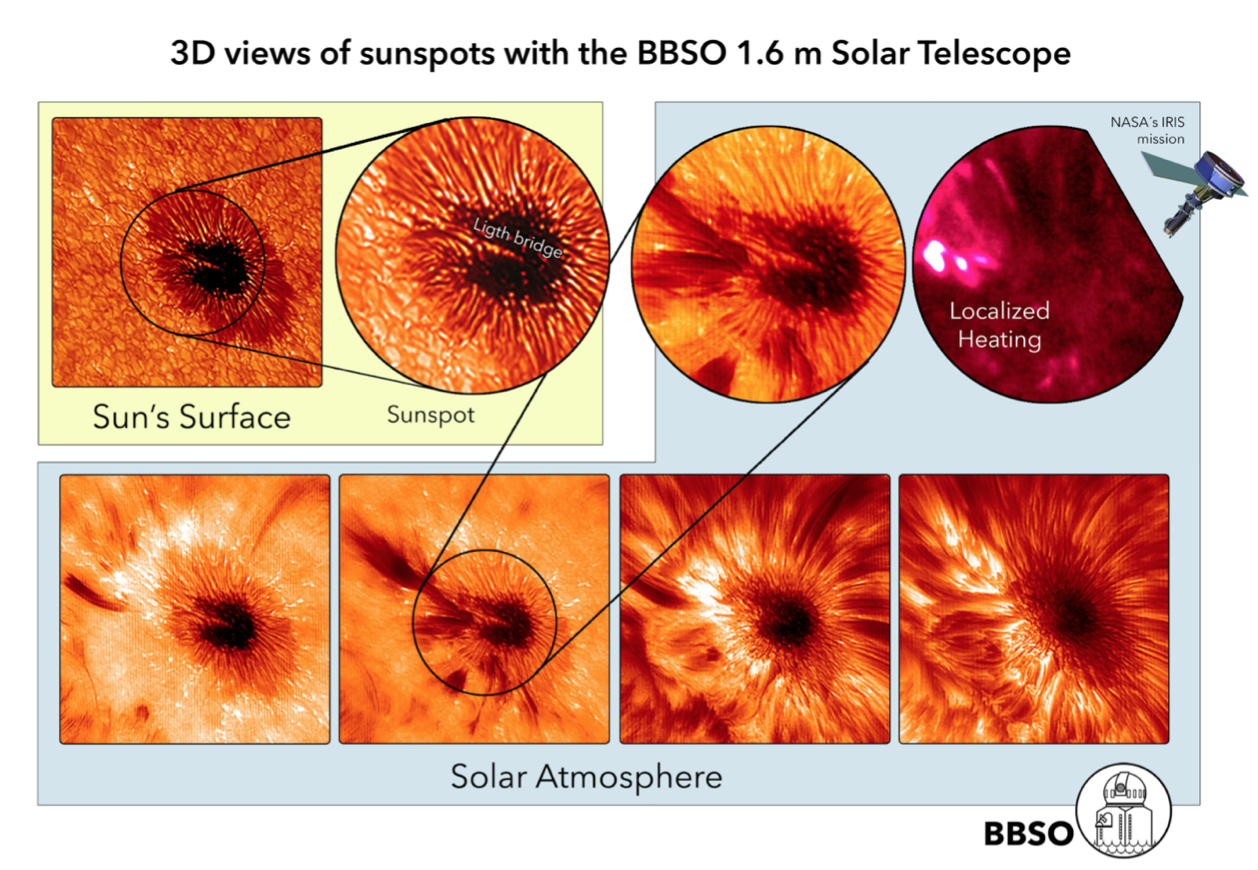 Multi-wavelength observations of sunspots with the 1.6-meter telescope at
Big Bear Solar Observatory (BBSO) in California and aboard NASA's IRIS
spacecraft have produced new and intriguing images of high- speed plasma
flows and eruptions extending from the Sun's surface to the outermost
layer of the solar atmosphere, the corona. The 1.6m New Solar Telescope
(NST) of Big Bear Solar Observatory allows us to investigate the structure
and dynamics of sunspots with unprecedented spatial and temporal
resolutions. The results of simultaneous observations of a sunspot in the
photosphere with a broad-band TiO-line filter and in the chromospheric
H-alpha line with Visible Imaging Spectrometer reveal previously
unresolved features of the sunspot umbra and penumbra. In particular, the
TiO data clearly demonstrate highly twisted dynamics of penumbral
filaments and umbral dots and reveal strong shearing plasma flows in
sunspot bridges, not explained by sunspot models. The high-resolution
H-alpha spectroscopic data provide new views of the sunspot chromospheric
dynamics, including the fine structure of oscillations and waves,
penumbral jets, ubiquitous small-scale eruptions, and accretion flows in a
form of dense plasma sheets. The diffraction-limited NST observations show
that the sunspot dynamics is more complicated and much richer than it is
described by the current sunspot models.
Multi-wavelength observations of sunspots with the 1.6-meter telescope at
Big Bear Solar Observatory (BBSO) in California and aboard NASA's IRIS
spacecraft have produced new and intriguing images of high- speed plasma
flows and eruptions extending from the Sun's surface to the outermost
layer of the solar atmosphere, the corona. The 1.6m New Solar Telescope
(NST) of Big Bear Solar Observatory allows us to investigate the structure
and dynamics of sunspots with unprecedented spatial and temporal
resolutions. The results of simultaneous observations of a sunspot in the
photosphere with a broad-band TiO-line filter and in the chromospheric
H-alpha line with Visible Imaging Spectrometer reveal previously
unresolved features of the sunspot umbra and penumbra. In particular, the
TiO data clearly demonstrate highly twisted dynamics of penumbral
filaments and umbral dots and reveal strong shearing plasma flows in
sunspot bridges, not explained by sunspot models. The high-resolution
H-alpha spectroscopic data provide new views of the sunspot chromospheric
dynamics, including the fine structure of oscillations and waves,
penumbral jets, ubiquitous small-scale eruptions, and accretion flows in a
form of dense plasma sheets. The diffraction-limited NST observations show
that the sunspot dynamics is more complicated and much richer than it is
described by the current sunspot models.
The results are presented by Alexander Kosovichev, Vasyl Yurchyshyn and Santiago Vargas Dominguez at the 224th meeting of the American Astronomical Society (AAS), held in Boston, Massachusetts on June 2, 2014. Link to the press-release materials.
Figure caption. Images of sunspot structure on the solar surface (top left) and at different heights above the surface (bottom row) obtained from the New Solar Telescope at Big Bear Solar Observatory (NJIT) on 29 September, 2013. The surface images show a dark central part (umbra) surrounded by filamentary penumbra, and an intrusion of hot plasma in the umbra ("light bridge"). The atmospheric images reveal fast plasma jets (bottom left), material accretion in the form of dense plasma sheets (second from the left) and very dynamic fibrils (two right panels). The sunspot activity is exceptionally strong in the "light bridge" area, above which the IRIS satellite detected sharply enhanced UV radiation (top right image). Image xredit: Santiago Vargas Dominguez & Alexander Kosovichev (BBSO/NJIT).
|
|
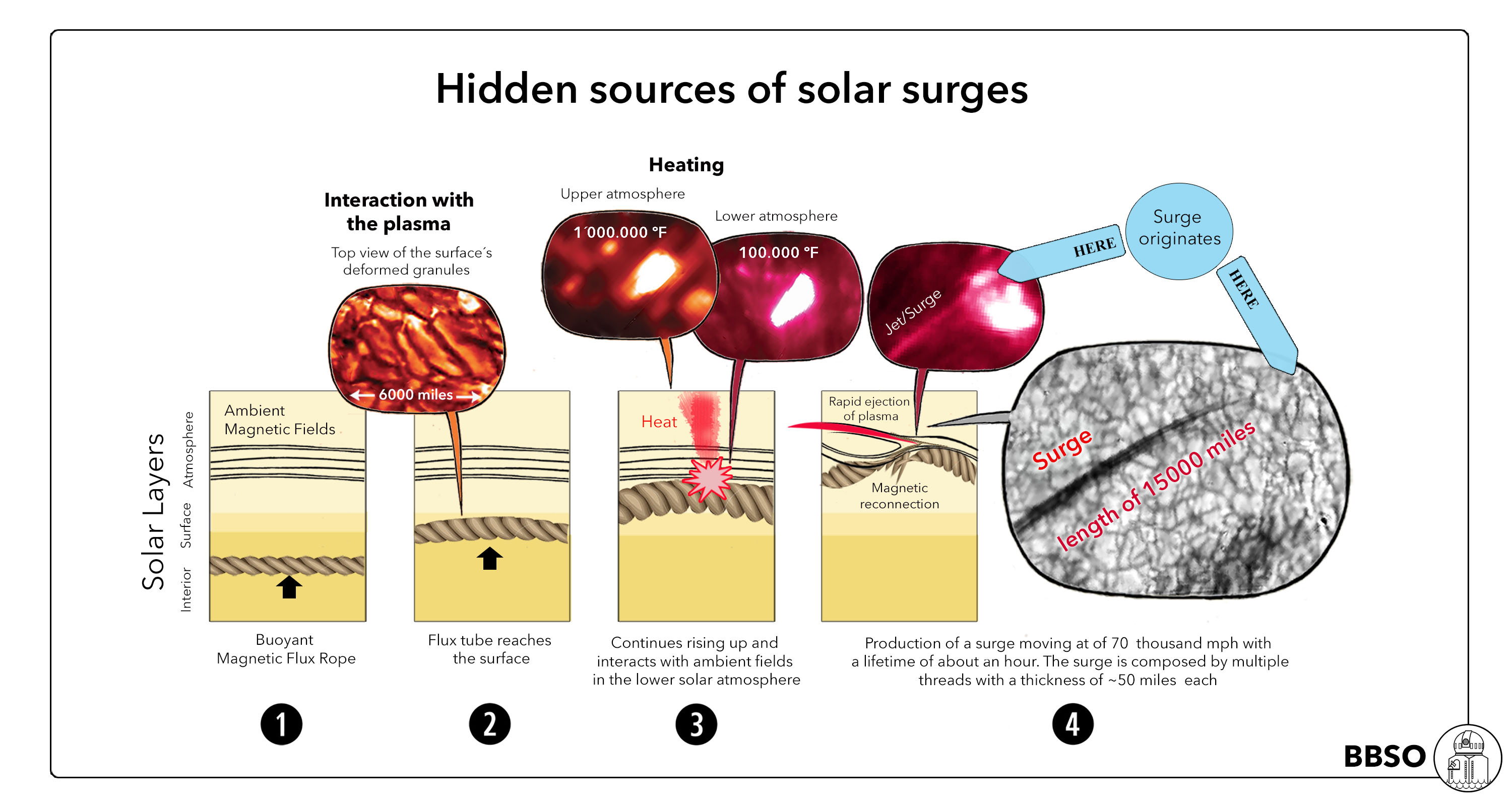 Cutting-edge observations with the 1.6-meter telescope at Big Bear Solar
Observatory (BBSO) in California have taken research into the structure
and activity of the Sun to new levels of understanding. Operated by New
Jersey Institute of Technology (NJIT), the telescope at Big Bear is the
most powerful ground-based instrument dedicated to studying the Sun.
A group of astronomers led by Dr. Santiago Vargas Dominguez have analyzed
the highest- resolution solar observations ever made and reported on the
emergence of buoyant "small-scale" magnetic-flux ropes on the solar
surface and the initiation of powerful plasma eruptions in the solar
atmosphere. The observations were performed as part of a program conducted
jointly with NASA's Interface Region Imaging Spectrograph (IRIS) mission,
Solar Dynamics Observatory (SDO) and Hinode satellite. These observations
provided a unique view of a magnetic-flux rope in the Sun's
surface-granulation pattern that was 6,000 miles long, and the interaction
between newly emergent and overlying ambient magnetic fields. This
research has shown that the complex action of small-scale and "hidden"
fields on the Sun is important for understanding how energy is transported
to the solar atmosphere. The process investigated can play a significant
role in mass and energy flow from the Sun's interior to the corona, the
solar wind and Earth's near-space environment.
investigated can play a significant role in mass and energy flow from the
Sun's interior to the corona, the solar wind and Earth's near-space
environment. The results are presented by Santiago Vargas Dominguez,
Alexander Kosovichev and Vasyl Yurchyshyn at the 224th meeting of the
American Astronomical Society (AAS), held in Boston, Massachusetts on June
2, 2014.
Link to the press-release materials.
Cutting-edge observations with the 1.6-meter telescope at Big Bear Solar
Observatory (BBSO) in California have taken research into the structure
and activity of the Sun to new levels of understanding. Operated by New
Jersey Institute of Technology (NJIT), the telescope at Big Bear is the
most powerful ground-based instrument dedicated to studying the Sun.
A group of astronomers led by Dr. Santiago Vargas Dominguez have analyzed
the highest- resolution solar observations ever made and reported on the
emergence of buoyant "small-scale" magnetic-flux ropes on the solar
surface and the initiation of powerful plasma eruptions in the solar
atmosphere. The observations were performed as part of a program conducted
jointly with NASA's Interface Region Imaging Spectrograph (IRIS) mission,
Solar Dynamics Observatory (SDO) and Hinode satellite. These observations
provided a unique view of a magnetic-flux rope in the Sun's
surface-granulation pattern that was 6,000 miles long, and the interaction
between newly emergent and overlying ambient magnetic fields. This
research has shown that the complex action of small-scale and "hidden"
fields on the Sun is important for understanding how energy is transported
to the solar atmosphere. The process investigated can play a significant
role in mass and energy flow from the Sun's interior to the corona, the
solar wind and Earth's near-space environment.
investigated can play a significant role in mass and energy flow from the
Sun's interior to the corona, the solar wind and Earth's near-space
environment. The results are presented by Santiago Vargas Dominguez,
Alexander Kosovichev and Vasyl Yurchyshyn at the 224th meeting of the
American Astronomical Society (AAS), held in Boston, Massachusetts on June
2, 2014.
Link to the press-release materials.
Figure caption. Cartoon illustrating the action of a six-thousand miles long magnetic flux rope rising up from the solar interior and stretching the granules. The interaction between the emerged and the ambient magnetic fields produces impulsive heating and an ejection of a plasma surge. Image credit: Santiago Vargas Dominguez (BBSO/NJIT)
|
|
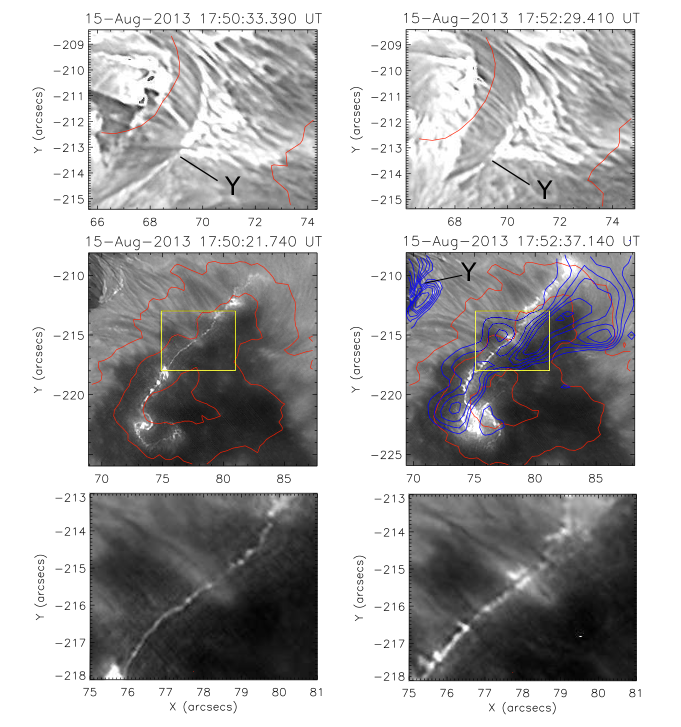 Emission of solar flares across the electromagnetic spectrum is often observed in the form of two expanding ribbons. The standard flare model explains the flare ribbons as footpoints of magnetic arcades, emitting due to interaction of energetic particles with the chromospheric plasma. However, the physics of this interaction and properties of the accelerated particles are still unknown. The results present multiwavelength observations of C2.1 flare of August 15, 2013, obtained
with New Solar Telescope (NST) of Big Bear Solar Observatory, Solar Dynamics Observatory (SDO), GOES and FERMI spacecraft. The observations reveal previously unresolved sub-arcsecond structure of the flare ribbons in regions of strong magnetic field consisting from numerous small-scale bright knots. The NST/VIS Halpha data (left) reveal superfine structuring of the chromospheric flare emission with a characteristic size of about 100 km, organized in a very thin but long, approx. 10,000 km ribbon crossing the sunspot region. The other flare ribbon, located in a flare region, is spatially diffused but also displays small-scale structuring. In addition, the chromospheric emission of the flare ribbons starts long before the HXR impulse. The observed heating before the appearance of hard X-ray emission cannot be explained by accelerated particles precipitating into the chromosphere, as assumed by the standard model of solar flares. There must be additional heating mechanisms associated with the superfine organized structuring of the flare ribbons. Such fine structuring suggests that the heating mechanism may be related to Joule heating by chromospheric electric currents. One of the most important open issues of this research is a very regular thread-like organization of the superfine structuring of the observed ribbons. This large-scale organization of the initial energy release needs further observational studies coupled with theoretical modeling.
Emission of solar flares across the electromagnetic spectrum is often observed in the form of two expanding ribbons. The standard flare model explains the flare ribbons as footpoints of magnetic arcades, emitting due to interaction of energetic particles with the chromospheric plasma. However, the physics of this interaction and properties of the accelerated particles are still unknown. The results present multiwavelength observations of C2.1 flare of August 15, 2013, obtained
with New Solar Telescope (NST) of Big Bear Solar Observatory, Solar Dynamics Observatory (SDO), GOES and FERMI spacecraft. The observations reveal previously unresolved sub-arcsecond structure of the flare ribbons in regions of strong magnetic field consisting from numerous small-scale bright knots. The NST/VIS Halpha data (left) reveal superfine structuring of the chromospheric flare emission with a characteristic size of about 100 km, organized in a very thin but long, approx. 10,000 km ribbon crossing the sunspot region. The other flare ribbon, located in a flare region, is spatially diffused but also displays small-scale structuring. In addition, the chromospheric emission of the flare ribbons starts long before the HXR impulse. The observed heating before the appearance of hard X-ray emission cannot be explained by accelerated particles precipitating into the chromosphere, as assumed by the standard model of solar flares. There must be additional heating mechanisms associated with the superfine organized structuring of the flare ribbons. Such fine structuring suggests that the heating mechanism may be related to Joule heating by chromospheric electric currents. One of the most important open issues of this research is a very regular thread-like organization of the superfine structuring of the observed ribbons. This large-scale organization of the initial energy release needs further observational studies coupled with theoretical modeling.
Original paper titled "Fine Structure of Flare Ribbons and Evolution of Electric Currents" by I. N. Sharykin and A. G. Kosovichev was published in June 10 2014 issue of Astrophysical Journal Letters.
( ADS/ArXiv)
|
|
 |
Recent observations of sunspot's umbra performed with the NST show that the sunspot's umbra is finely structured at a sub-arcsecond scale representing a mix of hot and cool plasma elements. Images and movies from NST's Visible Imaging Spectrometer reveal cool jet-like structures seen in the chromosphere of an umbra. The spikes are cone-shaped features with a typical height of 0.5-1.0Mm and a width of about 0.1Mm. Their life time ranges from 2 to 3 min and they tend to re-appear at the same location. The spikes are not associated with photospheric umbral dots and they rather tend to occur above darkest parts of the umbra, where magnetic fields are strongest. The spikes exhibit up and down oscillatory motions and their spectral evolution suggests that they might be driven by upward propagating shocks generated by photospheric oscillations. It is worth noting that triggering of the running penumbral waves seems to occur during the interval when the spikes reach their maximum height. |
Original paper titled "High Resolution Observations of Chromospheric Jets in Sunspot Umbra" by V. Yurchyshyn, V. Abramenko, A. Kosovichev, and P. Goode was published in May 20 2014 issue of Astrophysical Journal.
( ADS/ArXiv |
DOI)
|
|
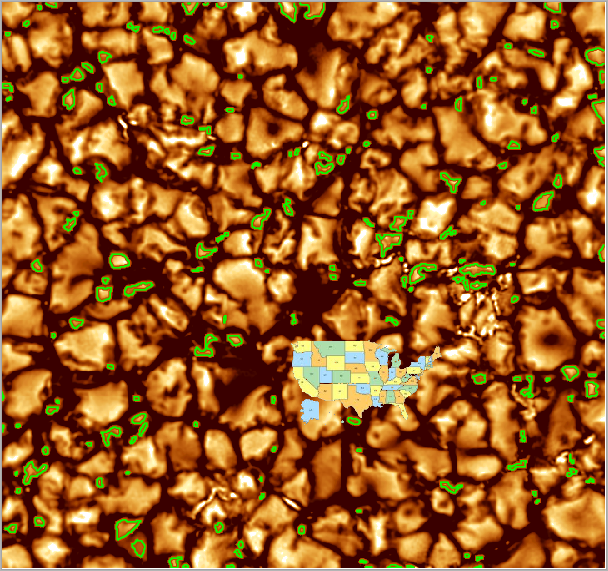
New observations of the solar granulation with the New Solar Telescope (NST) at the Big Bear Solar Observatory (BBSO) allowed a NJIT-Stanford research team to make the next step in understanding of the solar surface structure. A new complex world of very small granules became visible between normal solar granules. Mini-granules, as small as Maine, form a multi-fractal structure, similar to other systems in nature, such as coast lines, glaciers, earthquakes, stock market, etc. A key property of such systems is their unpredictable, burst-like behavior and jagged, irregular shape. Usually, occurrence of numerous independent random processes lead to the formation of a such system. Studying of such systems is beneficial for understanding both the universe and the social life.
The image shows solar granulation acquired with the NST on August 3, 2010 with overplotted contours of detected mini-granules (structures of equivalent diameter less than 600 km). The image size is 20500x19000 km. A map of USA is overplotted for comparison.
Until now it was thought that solar convection produces convection cells, visible on the solar surface as granules, of characteristic (dominant) spatial scale of about 1000km and a Gaussian (normal) distribution of granule sizes. In this case, the mechanism that produces granules is "programmed" to churn up convection cells of a typical size, without much freedom in size variation. Mini-granules do not display any characteristic ("dominant") scale, their size distribution is continuous and can be described by a decreasing power law (Gaussian distribution does not work any longer here) across all scales ranging from 140 to 2000 km. A majority (about 80%) of mini-granules are smaller than 600 km and about 50% are smaller than 300 km in diameter. This non-Gaussian distribution of sizes implies that a much more sophisticated mechanism, with much more degrees of freedom may be at work, where any very small fluctuation in density, pressure, velocity and magnetic fields may have significant impact and affect the resulting dynamics.
Scientist for long time saw difference in properties of small and large granules. However, low contrast and spatial resolution did not allow scientists to explore the entire range of structures. The NST provides images with contrast twice that of the previous data. It also enables us to see features on the solar surface as small as 80~km. These capabilities allowed us for the first time to accurately detect and measure very small convection cells. Their existence and properties were a subject of debate for long time, and now the NST solves the puzzle of the small (mini) granules.
Original paper titled "Detection of small-scale granular structures in the quiet sun with the New Solar Telescope" by V. I. Abramenko, V.B. Yurchyshyn, P.R. Goode (Big Bear Solar Observatory, NJIT) and I.N. Kitiashvili, A.G. Kosovichev (Stanford University) will be published by Astrophysical Journal Letters at the end of August, 2012
These results were published in Sept 2012 issue of Astrophysical Journal Letters (ADS | Arxiv).
|
|
 NST data show that solar magnetic fields may disperse over the solar surface
in the super-diffusion regime. Super-diffusivity was revealed on small scales (below 600 km)
and it opens new possibilities for local turbulent dynamo models. Properties and mechanisms
of flux dispersal over the solar surface are important constraints and clues for solar dynamo
theories. A spectrum of magnetic diffusivity defined on a broad range of temporal and spatial
scales is needed to calibrate diffusivity profiles in models of global solar dynamo. The new finding
indicates that the existing paradigm of normal (or sub) magnetic diffusivity needs
to be re-considered.
NST data show that solar magnetic fields may disperse over the solar surface
in the super-diffusion regime. Super-diffusivity was revealed on small scales (below 600 km)
and it opens new possibilities for local turbulent dynamo models. Properties and mechanisms
of flux dispersal over the solar surface are important constraints and clues for solar dynamo
theories. A spectrum of magnetic diffusivity defined on a broad range of temporal and spatial
scales is needed to calibrate diffusivity profiles in models of global solar dynamo. The new finding
indicates that the existing paradigm of normal (or sub) magnetic diffusivity needs
to be re-considered.
We studied proper motion of bright points (BPs) visible in the quiet sun (QS), in a coronal hole (CH), and in an active region plage (ARP, figure above from left to right). By tracking the BPs we were able to measure their displacements as a function of time. (Examples of BP's tracks are shown in the figure below, left, where the blue dots mark the start point). We then calculated the average (over all BPs) displacement for each time interval to obtain the average squared displacement as a function of time (the displacement spectrum, see the blue spectrum in the figure below, right).
 |
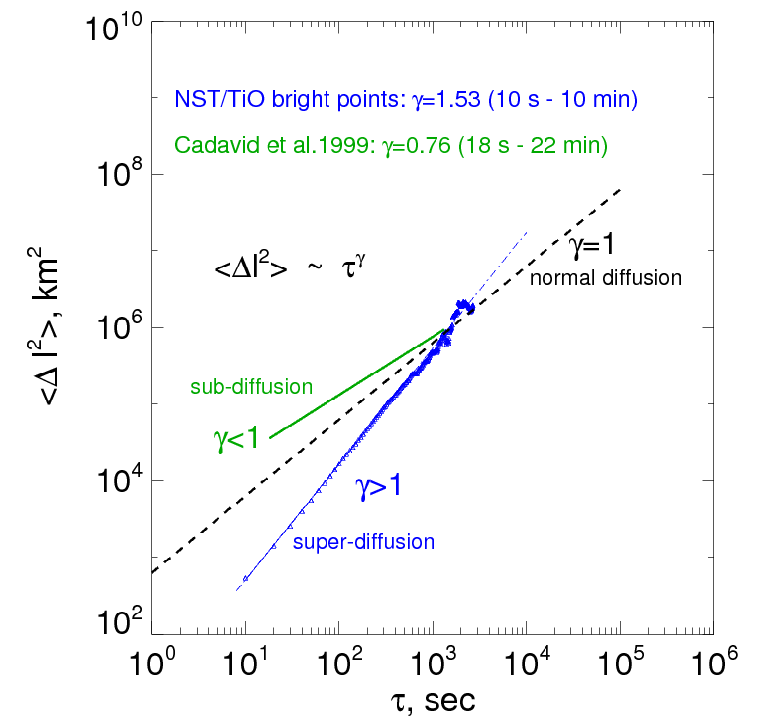 |
Using Kolmogorov turbulence theory, we were able to relate the coefficient of turbulent diffusion to the displacement spectrum and its index gamma. We thus found that the coefficient of turbulent diffusion changes in direct proportion to both temporal and spatial scales, which is the textbook definition of super-diffusivity. The coefficient of turbulent diffusion plotted as a function of temporal and spatial scales is shown below (NST data is represented with solid green, blue and red lines). For comparison, data from previous studies are also shown.
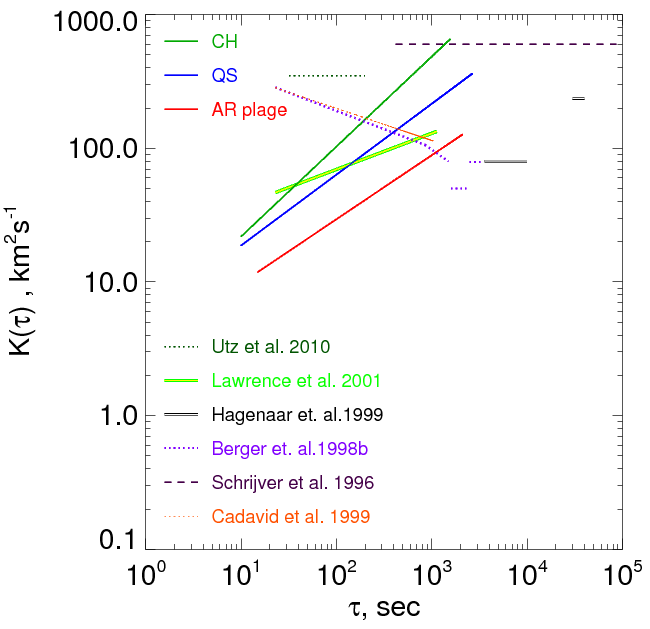 |
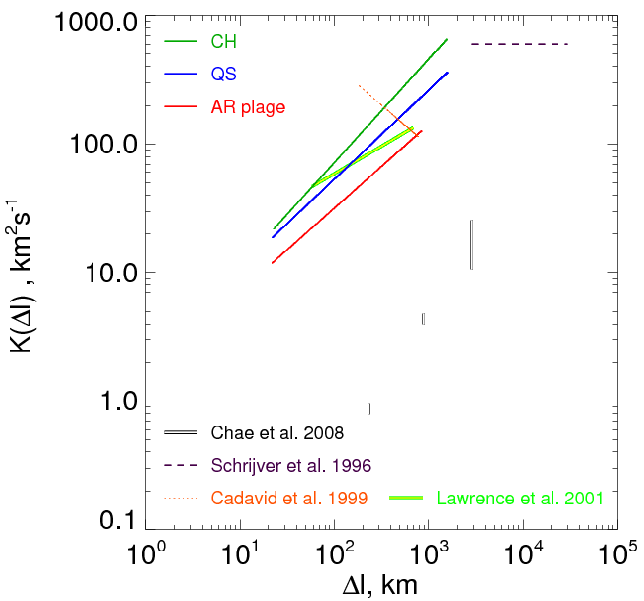 |
We also applied the same analysis to the 3D MHD model data of solar convection (Stein et al. 2007) and found the super-diffusion with gamma=1.45.
These results were published in Dec 2011 issue of Astrophysical Journal (ADS | Arxiv).
| Home |
|
|
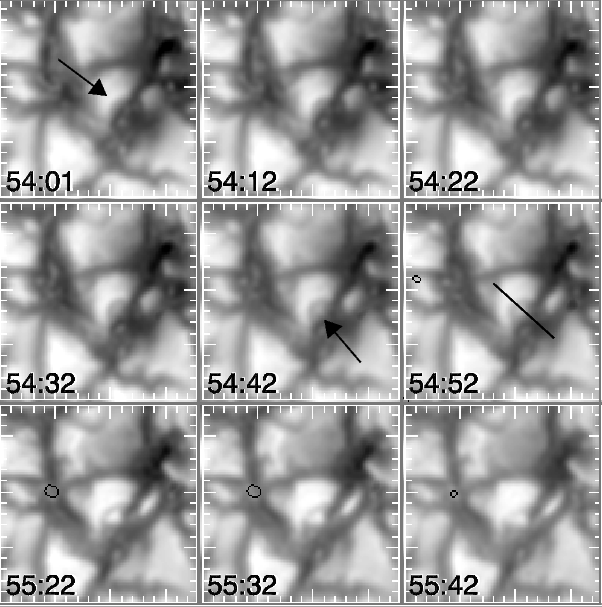 The BBSO's New Solar Telescope enabled us to resolve previously unknown, even
finer chromospheric features in blue shifted off-band H-alpha images. These
absorption features, arising from the dark intergranular lanes, are short-lived,
and show jet-like upflows. Their origin seems neither to be unequivocally tied
to concentrations of photospheric bright points nor predominantly associated
with the vertex formed by three (or more) granules. A visual inspection of NST
data revealed that they frequently originate from an intergranular lane separating two
granules. This is also the location where magnetic fields occur.
The BBSO's New Solar Telescope enabled us to resolve previously unknown, even
finer chromospheric features in blue shifted off-band H-alpha images. These
absorption features, arising from the dark intergranular lanes, are short-lived,
and show jet-like upflows. Their origin seems neither to be unequivocally tied
to concentrations of photospheric bright points nor predominantly associated
with the vertex formed by three (or more) granules. A visual inspection of NST
data revealed that they frequently originate from an intergranular lane separating two
granules. This is also the location where magnetic fields occur.
A small coronal hole (CH) located at N03E12 was observed using the NST with adaptive optics on August 31, 2010 from 17:40 to 18:16 UT. We used this data set to search for sources of small-scale intergranular jet-like events. We thus found that intergranular events are very often associated with rapidly evolving granules, more precisely, with instances in which granule fragments are pushed into the intergranular lane. A more detailed analysis of granular evolution led us to conclude that intergranular events are most often associated with what was identified by Steiner et al. (2010) as a vortex tube. At the same time, not every vortex tube event was accompanied by a chromospheric jet.
The Figure on the left shows a sequence of TiO images showing the development of a bright granular lane (BGL, arrow in 54:01 frame). The arrow in the first panel indicates a BGL, which slowly shifts toward the center of the granule as the lane evolves. The arrow in the 54:42 frame indicates a bright grain that usually accompanies the development of the BGL. The time stamp in each frame shows the minute and second of image acquisition, starting from 17:00:00~UT. Short tick marks separate 0.25~Mm spatial intervals.
At the peak of the BGL development, one or two jet-like darkenings, co-spatial with the BGL, may appear in the blue-shifted H-alpha images. These absorption features seem to originate in the intergranular lane adjacent to the bright grain.
Figure on the right shows a bright granular lane (BGL) associated with chromospheric activity. This is a sequence of composite images made by combining TiO granulation data and dark Ha-0.1~nm absorption features. The arrow in the 45:49 frame points toward the BGL. The onset of chromospheric jet-like activity begins shortly after a bright grain develops (frames 46:09-46:59). The arrow in the 48:17 frame indicates an inverted "Y" jet occurring at approximately the same position as the BGL. The time stamp in each frame shows the minute and second of image acquisition starting from 17:00:00~UT. Short tick marks separate 0.25 Mm spatial intervals.
Sequence of composite images showing the development of an elongated bright granular lane (BGL). The downward pointing arrows in the 59:02 and 00:24 frames indicate the BGL, while the upward pointing arrow marks the elongated bright grain. Two small and short-lived absorption features appear on either side of the grain between 18:03:39 and 18:04:40~UT. The time stamp in each frame shows the minute and second of image acquisition starting from 17:00:00~UT. Short tick marks separate 0.25 Mm spatial intervals, and the contour shapes in frames 03:18 - 03:39 show bright Ha-0.1nm patches.
According to the simulation data, the dark space between the bright grain and the BGL coincides with the axis of the vortex tube. The interpretation is that due to low pressure and temperature, the opacity above the vortex tube is reduced thus allowing us to peer deeper into its relatively cooler interior. As it follows from simulations, the associated magnetic field, is generally wrapped up in such a way, that the field is mainly aligned with the flow, i.e., it is rather perpendicular to the vortex tube axis. The high-speed flow above the vortex tube reaches up to the top of the photosphere with velocities up to 8~km/s and sweeps the magnetic field in the horizontal direction to the intergranular lane. It may be that this field collides with the nearby intergranular field of possibly opposing polarity, which has the potential to cause some chromospheric activity.
These results have been presented in August 2011 issue of ApJ Lett. 736/2, article id. L35 (2011), ( DOI: 10.1088/2041-8205/736/2/L35), (Bibliographic Code: 2011ApJ...736L..35Y)
| Home |
|
|
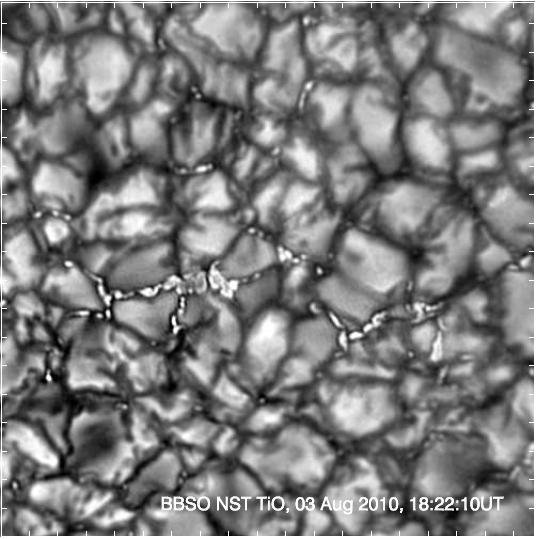 Bright points (BPs) observed in the solar photosphere are co-spatial and
co-temporal with magnetic elements and they are very reliable tracers
of transverse motions of photospheric magnetic flux elements. The mechanism for
the formation of BPs is thought to be a convective collapse of a magnetic flux
tube implying strong downflows and evacuation of the flux tube allowing us to
look deeper and see hotter plasma. Analysis of statistical distributions of BPs
can shed a light on the fundamental properties of smallest magnetic elements.
Bright points (BPs) observed in the solar photosphere are co-spatial and
co-temporal with magnetic elements and they are very reliable tracers
of transverse motions of photospheric magnetic flux elements. The mechanism for
the formation of BPs is thought to be a convective collapse of a magnetic flux
tube implying strong downflows and evacuation of the flux tube allowing us to
look deeper and see hotter plasma. Analysis of statistical distributions of BPs
can shed a light on the fundamental properties of smallest magnetic elements.
New high resolution data from NST established that these BPs could be much smaller then previously thought: the distribution function of their size extents down to the diffraction limit of NST, i.e., photospheric bright points can be even smaller than 80 km. The image on the left is an example of NST data and it shows solar granules with chains of small bright points between them. BPs usually cluster together at special locations on the solar surface where horizontal flows converge and sink, very much reminding the flow pattern at a street water drain.
Studies of BPs size and lifetime distributions are rather scanty. Earlier studies based on data from the Hinode space observatory reported a nearly Gaussian distribution of BP's size, with the peak located near 157 km.
Observations of solar granulation were performed with the NST's 1.6 meter clear aperture using a broadband TiO filter centered at a wavelength of 705.7 nm. The observations were made with tip-tilt and adaptive optics corrections and the data were speckle reconstructed.
To detect and track BPs, scientist created a tool that allowed them to automatically detect and track BPs in the NST images.
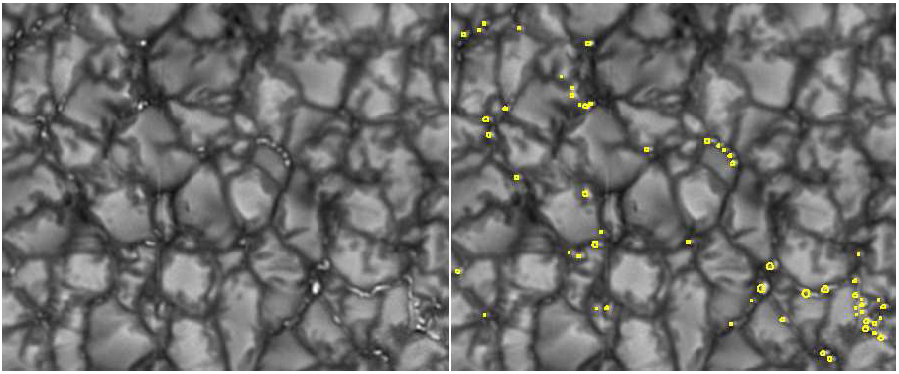 Two panels on the right show the same NST TiO image used to detect BPs with the image on the right overplotted with boundaries of detected BPs. This tool allowed scientists to measure size, lifetime, speed and the trajectory of each of BPs.
Two panels on the right show the same NST TiO image used to detect BPs with the image on the right overplotted with boundaries of detected BPs. This tool allowed scientists to measure size, lifetime, speed and the trajectory of each of BPs.
The six panel figure shows the probability distribution functions (PDFs) for
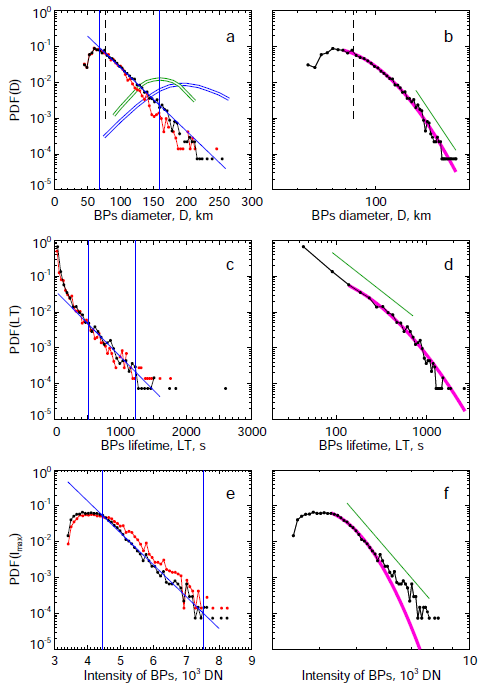 the diameter, D, lifetime, LT, and maximum intensity, Imax, of BPs.
In the left panels, results for two runs are shown: the black lines correspond
to the detection threshold of 85DN and the red lines to threshold of 120DN
(DN - Data Numbers). The right panels show PDFs only from the threshold of 85 DN.
the diameter, D, lifetime, LT, and maximum intensity, Imax, of BPs.
In the left panels, results for two runs are shown: the black lines correspond
to the detection threshold of 85DN and the red lines to threshold of 120DN
(DN - Data Numbers). The right panels show PDFs only from the threshold of 85 DN.
The difference between the two runs is small: for higher threshold the relative number of large-size events slightly decreases, and the relative number of brighter events slightly increases. The lifetime distribution does not appear to be affected by the threshold at all.
The PDF of diameters displays a nearly linear behavior in the linear-logarithmic plot (upper left). The monotonous increase is present down to the diffraction limit of NST. The saturation and the turnover of the observed PDF at scales smaller than 77km (to the left from the dashed vertical line) might be caused either by the fact than the NST does not purely resolve elements smaller than 77 km, or that elements much smaller than 77 km do not exist. For comparison, in the same panel we show the BP size distribution as derived from Hinode/SOT G-band images by Utz et al. (2009). In spite of a drastic difference in the shape of the PDFs derived from the two instruments, physically, they are consistent. The Hinode PDFs also saturate at scales corresponding to the diffraction limit of the Hinode/SOT telescope, which is 157 km for SOT observations in the G-band.
We thus conclude that the real minimal size of magnetic BPs (or magnetic flux tubes) has not yet been detected in observations with modern high resolution telescopes. As to the maximum size of BPs, the upper boundary for it seems to exist: as soon as BPs defined as those located inside intergranular lanes, the diameter of BPs cannot be larger than characteristic width of the intergranular lanes, which varies in a range of 150-400 km.
We also find that BP size distribution function has a log-normal shape. Unlike the power law, the log-normal distribution is not scale-free, therefore, there is a limit on a minimal size of an elementary flux tube, which may not have been achieved yet. The log-normal nature of the size distribution implies that the fragmentation and merging processes are important mechanisms contributing into evolution and dynamics of BPs. Frequent fragmentation and coalescence are clearly visible in the data set movie4. About 98.6% of all BPs live less than 120 s (12 time steps). This remarkable fact was not obvious from previous studies because an extremely high time cadence was required. The most important point here is that these small and short living BPs significantly increase dynamics (flux emergence, collapse into BPs, and magnetic flux recycling) of unipolar network areas. The magnetic field is thus fragmented into flux concentrations with well defined interfaces between them known as current sheets. Random motions of BPs, as well as often appearance/disappearance of new flux concentrations, will change the spatial distribution of the current sheets thus leading to release of energy.
These results have been presented in December 2010 issue of ApJ Lett., 725, L101-L105
| Home |
